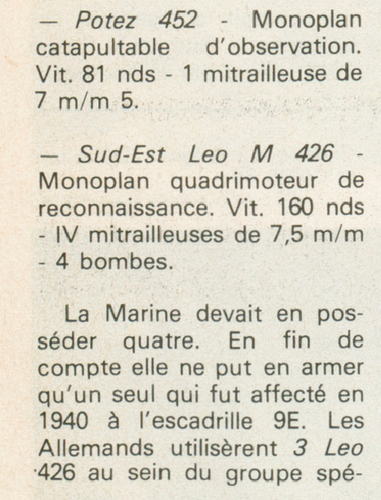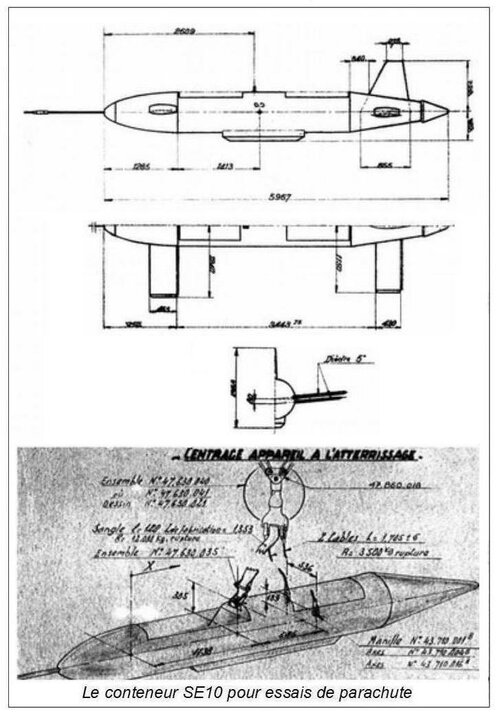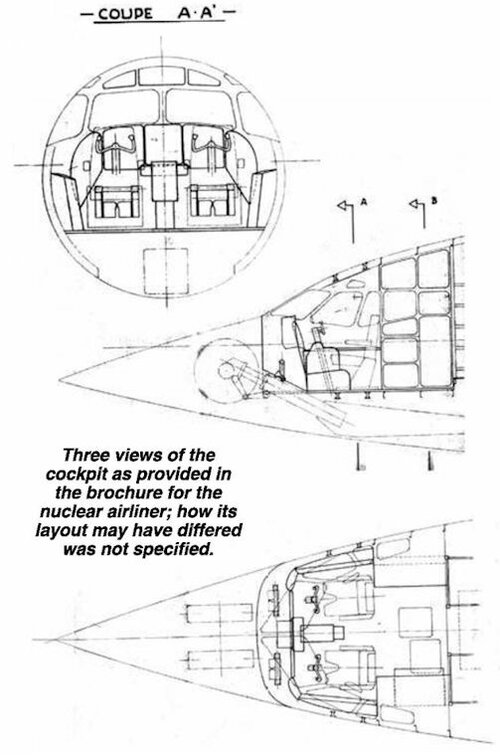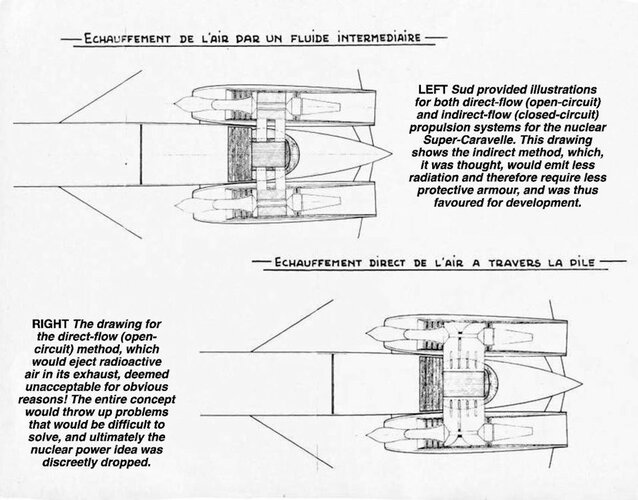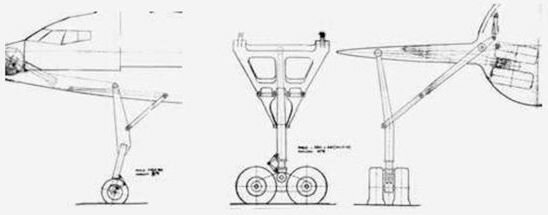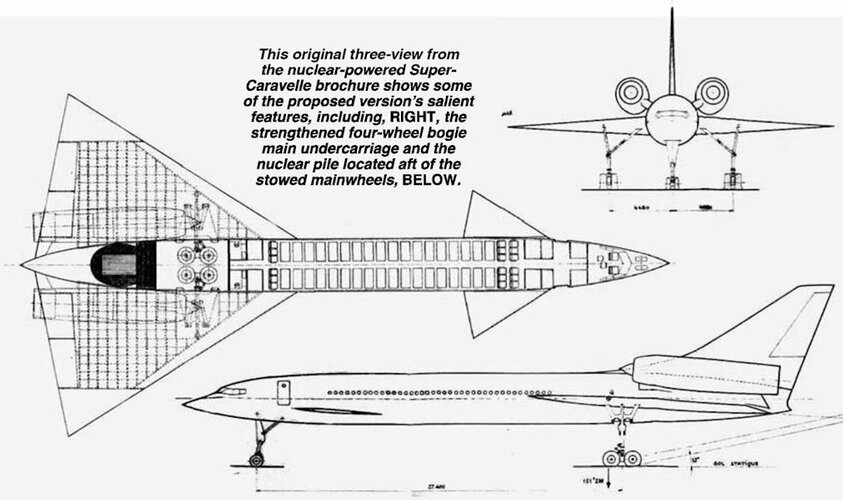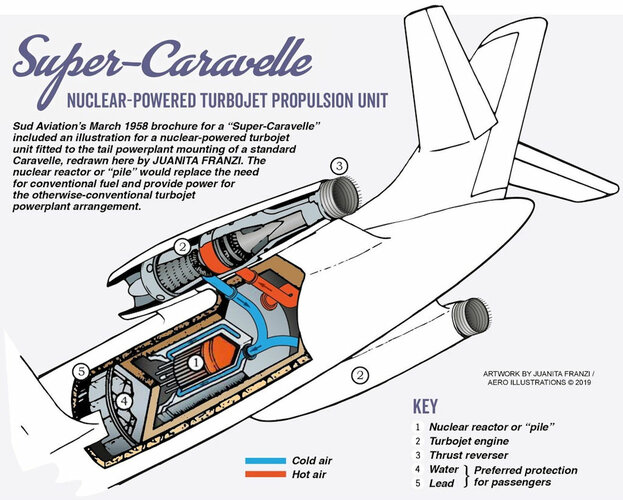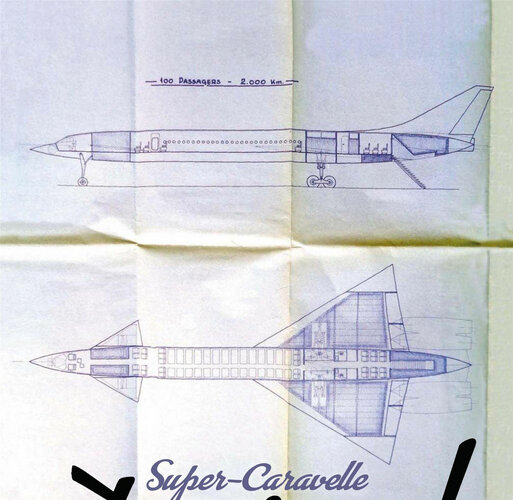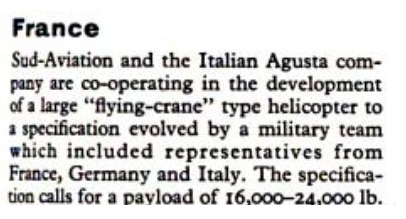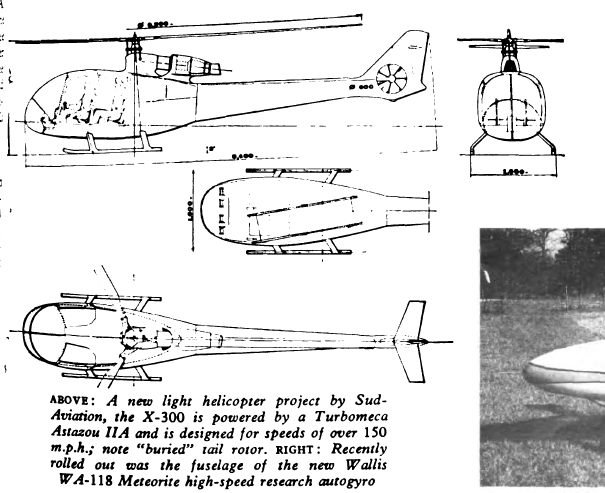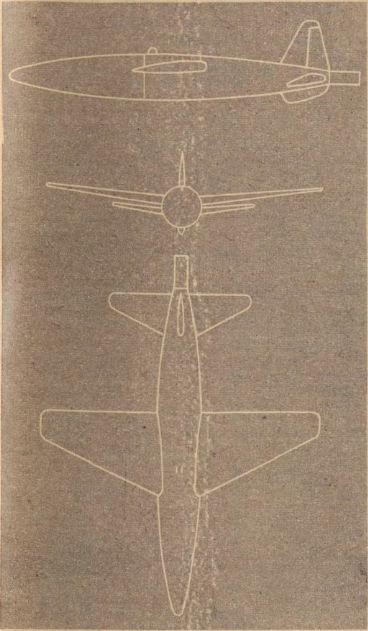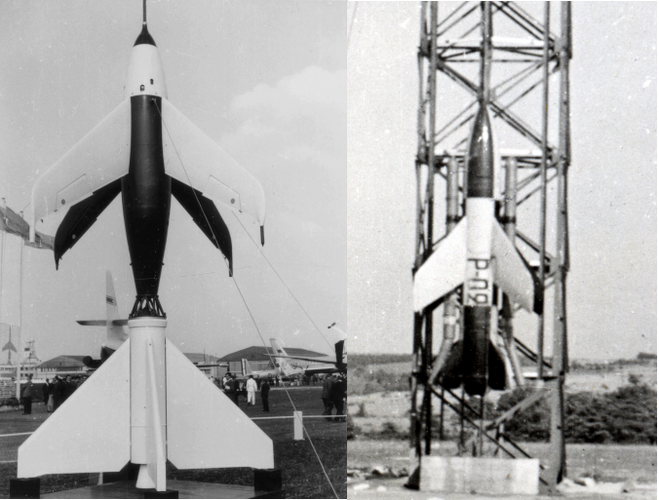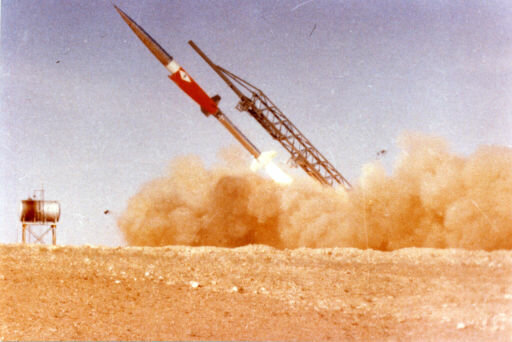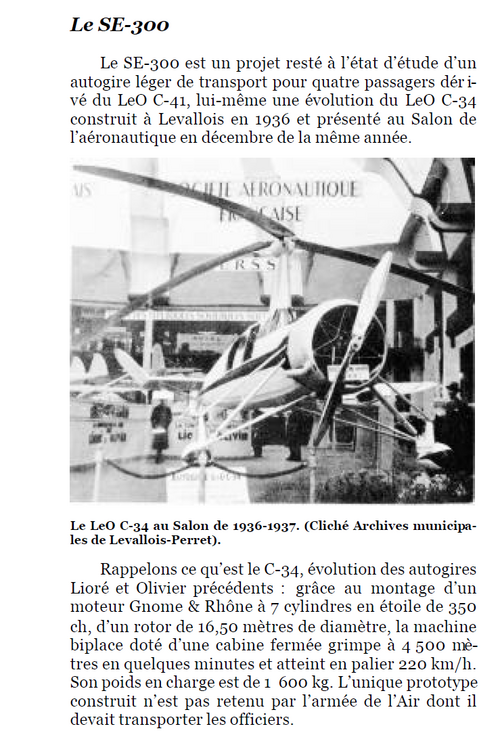You are using an out of date browser. It may not display this or other websites correctly.
You should upgrade or use an alternative browser.
You should upgrade or use an alternative browser.
SNCASE / Sud-Est Aviation designation (SE)
- Thread starter AM
- Start date
- Joined
- 9 October 2009
- Messages
- 21,944
- Reaction score
- 13,576
No need. Just add a note about the correct identification.
Bazinga
I really should change my personal text
- Joined
- 14 December 2012
- Messages
- 292
- Reaction score
- 406
This is the SE X-205Could this be the SE X-250? Something of a design evolution of the SE-210 Caravelle. Ultimately the Caravelle Horizon was proposed but superseded by the Super Caravelle SST. She seems too small for the 30p SE X-205. 1952 AW&ST source.
View attachment 628080
- Joined
- 26 May 2006
- Messages
- 34,869
- Reaction score
- 15,733
I will make a SNCASE & Sud-Aviation list;
SE-161 Languedoc was a forty-seat transport monoplane,started as the Bloch MB-161
SE-20 Aquilon was a license-built De Havilland Sea Venom
SE-201 Aquilon was a two-seat night pursuit version of 1952
SE-202 Aquilon was a DH Sea Venom derivative
SE-203 Aquilon was a single seat fighter version
SE-204 Aquilon was a two-seat jet trainer version
SE-247 was developed from LeO H-47,as a military derivative version of 1945
SE-520 was a Projected version of Dewoitine D.520
SE-520Z was ex Dewoitine
SE-530 Mistral was a license-built De Havilland Vampire
SE-531 Mistral was a license-built De Havilland Vampire with Nene 102B engine
SE-532 Mistral was a license-built De Havilland Vampire with Nene 104 engine and ejector seat
SE-533 & SE-534 Mistral were unknown variants,maybe a Projects
SE-535 Mistral was a navel fighter version
SE-580 was a post-war Project fighter derived from D.520 with dorsal air intake,powered by one Hispano-Suiza 12Z
engine
SE-581 was a Project version,powered by one 2500 hp Hispano-Suiza 24Z engine
SE-582 was a Project version,powered by one 4000 hp Arsenal 24H engine
SE-100 was an initially designed the LeO 50,powered by two 1081 hp Gnome-Rhône 14N-20 or Gnome-Rhône 14N
-21 engines
SE-100-02 was a version of SE-100,powered by two Gnome-Rhône 14N
SE-101 was a three-seat fighter in C.3 category,powered by two 750 hp Hispano-Suiza 14 AB-02/03 engines,later
re-engine with 1100 hp Pratt and Whitney Twin Wasp R-2000 engines
SE-102 was a three seat observation light bomber version,in AB3 category,powered by two Gnôme-Rhône 14 N2/3
or 14N40/41 engines
SE-103 was anther AB3 version,powered by two 1150 hp Hispano-Suiza 14AA-12/13 engines
SE-104 was unknown version
SE-105 was a version of SE-100,with two auxiliary tanks and powered by two 1320 hp Gnôme-Rhône 14 R4/5 engines
SE-110 was an initial name for SE-101
SE-120 & SE-121 maybe were a single seat mono-motor fighter Projects,need confirm
SE-122 was a single seat recce Project version of SE-100,a scale down configuration,powered by single engine,driven
two counter-rotating propellers
SE-200 Amphitrite was a formerly LeO H-49 large transport flying boat,powered by six 1600 hp Gnome-Rhône 14
R-26 & R-27 engines
SE-200 Lourd was a very heavy Project version,with 200 ton empty weight
SE-200 Affine was a version,with single-tail empennage and elongated hull,powered by six Gnôme-Rhône 18R and
78 ton empty weight
SE-200/4 was a four engined Project version,and simplified configuration
SE-201 & SE-202 were unknown variants,maybe a Projects only
SE-203 was a version,powered by six Gnome-Rhône 14R engines,and 68 ton empty weight
SE-204 was a version,powered by six Gnôme-Rhône 18R engines,and 80 ton empty weight
SE-204M was a military version of SE-204,powered by six Gnôme-Rhône 18R engines,with defensive and offensive weapons
SE-205 & SE-206 were unknown Project versions
SE-207 maybe was aversion ,powered by six Gnôme-Rhône 18R engines,and 90 ton empty weight
SE-208,SE-209,SE-210 & SE-211 were unknown Project versions
SE-212 was a Project version of SE-200,powered by six Gnôme-Rhône 18R, wing area increase of 35 m° and 90 ton empty weight
SE-300 was a light transport autogyro Project,powered by one 350 hp Gnôme-Rhône engine
SE-300T was a twi engined project for T3 category (ex Ronamo 111)
SE-400 was a three-seat mid-wing surveillance seaplane,on floats,powered by two 655 hp Gnôme-Rhône 14M
engines
SE-500 was a four seat light bomber Project version of SE-100,powered by two 1050 hp Gnôme-Rhône N-48/49
or 1600 hp Gnôme-Rhône 14R engines
SE-500T was a twin-engine 12 passenger cargo/transport Project,powered by two 1050 hp Gnôme-Rhône 14R
engines
SE-600 was a two-seat armed recce experimental Project,based on SE-100,but powered by one 350 hp Bearn
6D engine
SE-600/I was a light transport Project version,also powered by one 350 hp Bearn 6D engine
SE-700 was a three-seat passenger autogyro,powered by one 330 hp Béarn 6D-07 engine
SE-700S was an improved version,maybe remained a Project,
SE-701 was a version,intended to carry 700 kg of load,powered by one 220 hp Renault 6Q-01 engine,also known
as SE-700A
SE-702 was a version,featured by a fuselage hull and a fixed front wheel,powered by one 330 hp Béarn 6D-07 engine,
also called SE-700B
SE-800 was a transport Project developed from SE-100,22 passenger and four crew,powered by either 1350 hp
Gnome-Rhône 14 or 1650 hp Wright Cyclone engines
SE-800A was a 24 passenger and four crew,powered by two 1300 hp Gnome-Rhône 14 R engines,Project
SE-800B was a 33 passenger and four crew,powered by four 1000 hp Hispano-Suiza 12 Y engines,Project
SE-800C was a 24 passenger in cabin waterproof,powered by two 1600 hp Gnome-Rhône 14 R engines,Project
SE-900 was a high-wing twin engined flying boat project,may intended for military and civil roles
SE-1000 was a mid-wing stratospheric transatlantic postal transport monoplane Project,powered by four
1590 hp Gnome-Rhône 14 R engines
SE-1001 was a Project version of SE-1000,with re-designed the nose and cockpit configuration,as a long-
range mail carrier
SE-1010 was a high-altitude photo-survey aircraft,powered by four 1600 hp Gnome-Rhône 14 R-28/29 engines
SE-1011 was a production aircraft: three under construction when Project was abandoned
SE-1015 was a long-range 18 passenger courier airliner Project,powered by four 1600 hp Gnome-Rhône 14 R-28/29 engines
SE-1020 was a maritime patrol aircraft Project,with gun turret,powered by four Junkers Jumo 213 engines
SE-1030 was a proposed 40 passenger airliner variant Project,powered by four 1600 hp Gnome-Rhône 14 R-28/29 engines
SE-1035 was a high Speed Stratospheric airliners from 1947 with a more conventional larger diameter airliner
fuselage design,powered by four 1600 hp Gnome-Rhône 14 R-28/29 engines
SE-1040 was a proposed turboprop test-bed to evaluate the Rolls-Royce Dart engine
SE-1100 was a redesigning of SE-200C.,as a civil/military transport flying boat Project,120 ton empty weight
SE-1200 was a 125 passenger heavy version of SE-200,but powered by eight 3400 hp Arsenal 24H engines,
140 ton empty weight,Project
SE-1210 was a sub-scale version of SE-1200,powered by four 240 hp Renault 6Q engines
SE-1200/I was a medium transport compound helicopter Project,with shoulder wing and addition two
piston engines,mounted on it and the a low rear wing with twin tail fins
SE-1300 was a very large and heavy version of SE-200,with 180 ton empty weight,Project
SE-1400 was a projected sub-scale flying mock-up of SE 2400 or heavy jet fighter derived from SE 2400,powered
by one Rolls Royce Derwent V turbojet engine,Project
SE-1410 was a projected sub-scale flying mockup of SE 2400,but powered by Walter HWK 109/509 rocket
engine
SE-1400/I was a side-by-side two seat attack aircraft Project,powered by two Hispano-Suiza Nene turbojets,mounted
beside the fuselage with wing roots,later redesigned and developed into SE-2450
SE-1500 was a unguided, effect of explosions, 10 to 200 m from the vehicle (1946)
SE-1501 was a unguided target (1948)
SE-1502 was a unguided target (1950)
SE-1502M was a Navy recoverable target (1953)
SE-1503 was a turbojet powered target (1953)
SE-1504 was a developed project version of SE-1500
SE-1510 was a guided and recoverable target(1948)
SE-1511 was a test of optical guidance (1952)
SE-1520 was built but not flown; five were modified into SE 1502M and five more into SE 1523
SE-1521 was a experimental flying bomb (1949)
SE-1522 was a recoverable target (1952)
SE-1523 was a Navy operational recoverable target (1953)
SE-1524 was an Air Force operational recoverable target (1953)
SE-1530 was a built and not flown; seven were modified into SE 1522 and two into SE 1523.
SE-1531 was a rocket powered variant (1952)
SE-1600 was an experimental aircraft with additional vertical control surfaces Project,no more details
SE-1610 was a version of SE.1600 powered by pulse-jet. Project only
SE-1700 unknown Project,maybe a tourism glider,need confirm
SE-1800 was an two-seat experimental twin-jet transport flying wing Project,powered by two Rolls Royce Nene
turbojet engines
SE-1801 was a Project version of SE-1800,but powered by two Snecma ATAR turbojet engines
SE-1802 was a Project version of SE-1800,also powered by a less propulsion Rolls Royce Nene turbojet engines
SE-1900 was a rocket-powered wheeled car
SE-1910 was a record-breaking variant of above
SE-2000 was a mid-wing transatlantic heavy transport Project,powered by four 2100 hp Gnôme Rhôme R18
engines
SE-2001 was a unknown Project version,need Info
SE-2010 Armagnac was a enlarge version of SE-2000,with a cantilever mid-wing monoplane with retractable tricycle landing gear,powered by four 3500 hp Pratt & Whitney R-4360-B13 Wasp Major engines
SE-2020 was a version of SE-2010 with bigger wheels (1,72 m instead of 1,52 m),Project,maybe powered by
the same engines
SE-2030 was a version of SE-2010,but powered by four Cyclone turboprop engines
SE-2040 was a projected derivative of SE-2010,with four Allison T40 turboprop engines and longer fuselage
SE-2043 was a Project version from SE-2010,powered by four Bristol Proteus turboprop engines
SE-2050 was unknown Project version,need Info
SE-2060 was a test bed aircraft of SE-2010 transport aircraft with eight ATAR engines
SE-2100 was a two-seat light and touring tailless airplane,powered by one 190 hp Renault 4Pei pusher engine
SE-2200 was a single seat naval fighter Project,based on SE-580
SE-2300 was a two-three seat low-wing light and touring monoplane,powered by one 140 hp Renault 4Pei engine
SE-2301 was a developed version of SE-2300,need Info,maybe a Project
SE-2310 was a three-seat, tricycle undercarriage version,powered by one 190 hp Renault 4Pei engine
SE-2311 was a version of SE-2310,with retractable gear and fuel canisters in wings,maybe with the engine
SE-2320 was a project to a four-seater version of SE 2310 with 3-wheel retractable landing gear
SE-2400/I was a low-mid-wing single seat experimental attack monoplane Project,powered by two Socema CEM
turbojet engines,mounted under each wing
SE-2400/II was a single seat mid-wing experimental attack monoplane Project,powered by two Rolls Royce Nene
turbojet engines,mounted in dorsal intakes
SE-2410 Grognard I was a single seat low-level ground attack experimental monoplane prototype,powered by two Hispano-Suiza (built under license RR) Nene 101 turbojet engines
SE-2411 Grognard was a developed version from SE-2410,powered by Rolls Royce Nene 102 turbojet engines,need
confirm
SE-2412 Grognard maybe a misprint
SE-2415 Grognard II was a two-seat as a development version,that included a stretched fuselage incorporating a
raised cockpit with a bubble canopy and reduced 32˚ wing sweep back,powered by the same engines
SE-2416 Grognard was a single seat strike aircraft Project version,with four HS 603 30mm machine guns,also
the same engines
SE-2417 Grognard was a SE-2415,re-engine with Tay or Verdon turbojets,and fitted with eight 20mm guns,Project
SE-2418 Grognard was a single seat version,this design mated a highly swept wing SE-2410 and SE-2415 fuselage,
with two 30mm guns,and the same engines,Project
SE-2418/I Grognard was a version,powered by two Snecma ATAR 101F turbojet engine,mounted side-by-side,
and two 30mm guns,Project
SE-2419 Grognard was a direct adaption of SE-2418 with two Rolls Royce Nene turbojets,and two 30mm guns,
Project
SE-2420 Grognard III was based on third prototype (SE-2415) with thin wings,with two Tay turbojets,never
completed
SE-2421 Grognard was a two-seat long-range all-weather fighter Project,based on SE-2420 and same engines
SE-2422 Grognard was a single seat strike aircraft Project,with thin wings and featured a revised air-intakes
(lesser bulky but wider),maybe with RR Nene engines
SE-2422R Grognard was a single seat recce version of SE-2422,with cameras in place of gun bay
SE-2423 Grognard was a design version,mated the fuselage of SE-2418 with the wings of SE-2415,Project
SE-2424 Grognard was anther version of SE-2418,but with Snecma Vulcain P-150 engines with post combustion
SE-2450 Grognard was a simplified SE-2400/I,side-by-side two-seat with bubble canopy and pursuit radar,and
powered by two Hispano-Suiza Nene turbojets,mounted beside the fuselage with wing roots,Project
SE-2500 was a designation mentioned as similar to the X-201.02.01,jet airliner Project
SE-2600 was a ground-to-air rocket engine for SA.20 program. Project only
SE-2610 was a reduced model of SE.2600. Project only
SE-2700,SE-2800 & SE-2900 were unknown designs,maybe not used
SE-3000 was a heavy two rotor transport helicopter project (also allocated to former Focke-Achgelis Fa 223)
SE-3001 was a flying model of the SE-3100
SE-3010 was unknown Project,need confirm
SE-3100 was a twin-engine single-rotor large helicopter Project,with unusual twin, angled tail rotors
SE-3101 was an experimental sub-scale prototype version of SE 3100, first French helicopter
SE-3110 was a two-seat experimental light helicopter,powered by one 200 hp Salmson 9 Nh engine,with unusual twin, angled tail rotors
SE-3111 was a variant Project fitted with rotors larger diameter tail (2.80 m instead 2.40 m),based on SE-3110
SE-3120 Alouette was a single seat crew and two seat utility helicopter,powered by one 200 hp Salmson 9 Nh engine
SE-3130 Alouette II was enlarge version of SE-3120,with one crew and four seat,utility and multi-role helicopter,
powered by one 530 hp Turbomeca Artouste IIC6 turboshaft engine
SE-3131 Gouverneur was a version of Alouette
SE-3140 was Alouette II modified with shorter main rotor blades anf 400 hp Turbomeca Turmo turboshaft
engine
SE-3150 Lama was Allouette II,fitted with larger main rotor,3-blade tail rotor and powered by one 500 hp Turbomeca
Artouste III turboshaft engine
SE-3160 Allouette III was a redesigned Allouette II with all-metal monocoque fuselage,and a fully enclosed seven-seat cabin and fixed tricycle undercarriage,powered by 870 hp Turbomeca Artouste IIIB turboshaft engine
SE-3164 was Allouette II with stepped windshield and nose-mounted 20mm gun,prototype
SE-3170 was unknown Project
SE-3180 Allouette was Allouette II fitted with 450 hp Turbomeca Artouste II turbine for high altitude operation,
prototype
SE-3190 was SE-3160 fitted with 600 hp Turbomeca Astazou XIV turboshaft engine,prototype
SE-3200 Frelon was a heavy transport helicopter with single four-blade main rotor,powered by three 750 hp
Turbomeca Turmo IIIB turboshaft engines,positioned in housing on top of fuselage
SA-3210 Super Frelon was developed from SE-3200,with boat hull and outrigger floats,rear loading doors,boom tail,
six-blade main rotor driven three 1320 hp Turbomeca Turmo IIIC turboshaft engines
SA-3220 Super Frelon was enlarge version of total mass 10 ton,with single five-blade main rotor,the waterproof
hull was extended at the front by a bow and bent tail (foldable) used to raise the anti-torque rotor,powered by
three 1250 hp Turbomeca Turmo IIIC turboshaft engines,Project
SA-3230 Super Frelon was a Project version of SE-3220,its empty mass was 4,800 kg and its total takeoff weight was only 9 ton,and powered by only two 1320 hp Turbomeca Turmo IIIC turboshaft engines
SA-330 Puma was a medium-lift 20 troop military helicopter with retractable tricycle undercarriage and single
four-blade main rotor ,powered by two 1320 hp Turbomeca Turmo IIIC4 turboshaft engines
SA-340 Gazelle was a light five-seat multi-role helicopter,with streamlined fuselage,tail rotor,three-blade main
rotor,powered by one Turbomeca Astazou IIN2 turboshaft engine
SE-4000 was a high-wing amphibian flying boat light transport Project,powered by one 450 hp Mathis 16G
pusher engine,mounted above the wing
SE-4010 maybe unknown Project version of SE-4000
SE-4020 was a twin-engine amphibious seaplane, powered by two 330 hp De Havilland Gipsy Queen 70 engines. 1949, project only
SE-4030 was a high-wing amphibian flying boat light transport Project,enlarge version of SE-4000,powered by two Armstrong Siddeley Cheetah or P&W engines,in tractor position
SE-4040 was a light transport aircraft, land version of the SE.4030, powered by two 410 hp Armstrong-Siddeley Cheetah 10 engines. 1949, project only
SE-4100 was a first French rocket, Project only
SE-4101,SE-4102,SE-4103,SE-4104,SE-4110,SE-4111,SE-4112,SE-4113,SE-4114,SE-4115,SE-4116,SE-4117,SE-4118 &
SE-4119 were a variants of SE-4100
SE-4120 & SE-4130 were unknown
SE-4140 was a variant of SE-4100
SE-4200 was a first operational ramjet-powered ground-to-ground missile
SE-4201 was a variant of SE-4200
SE-4202 was a variant of SE-4200
SE-4204 was a variant of SE-4200
SE-4205 was a variant of SE-4200
SE-4207 was a variant of SE-4200
SE-4208 was a variant of SE-4200
SE-4209 was a variant of SE-4200
SE-4210 was a variant of SE-4200
SE-4211 was a variant of SE-4200
SE-4212 was a variant of SE-4200
SE-4213 was a variant of SE-4200
SE-4220 was a variant of SE-4200
SE-4230 was a variant of SE-4200
SE-4241 was a variant of SE.4200. 26 built, 1st launch 8th March 1955
SE-4242 was a variant of SE.4200. 82 built, 1st launch 3rd June 1955
SE-4243 was a variant of SE.4200. 4 built, 1st launch 18th October 1955
SE-4243 was a variant of SE.4200. Not built
SE-4245 was a variant of SE.4200. 30 built, 1st launch 13th November 1956
SE-4246 was a variant of SE.4200. 94 built, 1st launch 25th February 1958
SE-4247 was a variant of SE.4200. 20 built, 1st launch 6th June 1957
SE-4261 was a variant of SE.4200. 32 built, 1st launch 20th October 1954
SE-4262 was a variant of SE.4200. 10 built, 1st launch 7th June 1958
SE-4263 was a variant of SE.4200. 60 built, 1st launch 8th June 1955
SE-4270 was a variant of SE.4200. Not built
SE-4280 was a variant of SE.4200. 108 built, 1st launch 5th May 1959
SE-4290 was a variant of SE.4200. Not built
SE-4299 was a target,need Info
SE-4300 was a variant of SE-4100 with French radar
SE-4350 was a variant of SE.4300 with SEPR 50531 rocket. 89 built, 41 launched
SE-4400 was a ramjet-powered ground-to-air missile. 74 built, 1st launch 9th April 1954
SE-4401 was a variant of SE.4400. 18 built, 1st launch 4th June 1954
SE-4402 was a record-breaking variant SE.4400
SE-4500 was a enlarged ramjet-powered version of the SE-4200 intended to carry a 700-kg bomb at a distance of
130 kms
SE-4600.SE-4700,SE-4800 & SE-4900 probably not used
SE-5000 Baroudeur was a single seat high-wing lightweight strike fighter monoplane,powered by one Snecma
ATAR 101D turbojet engine
SE-5000-01 Baroudeur was a first prototype built,powered by one Snecma ATAR 101C turbojet engine
SE-5000-02 Baroudeur was a second prototype built,with some modifications
SE-5001 Baroudeur maybe it was a version with two addition Rolls Royce Soar booster engines
SE-5002 Baroudeur A was a smaller version,powered by one Bristol Siddeley Orpheus II turbojet engine
SE-5003 Baroudeur was a pre-series version,that incorporated test for many engines,ATAR E3,E4 & D3
SE-5004 Baroudeur was a version,powered by one Snecma ATAR E4 engine
SE-5005 Baroudeur maybe a misprint in L+K magazine,as a version with additions two rocket powered engines
SE-5008 Baroudeur was a proposed series version with Snecam ATAR 8 engine
SE-5008 VS Baroudeur was anther Project with blown wing,powered by one Snecma ATAR 8 engine
SE-5010 Baroudeur L was a light tactical support variant
SE-5012 Baroudeur was a proposed series version with one Bristol Siddeley Orpheus engine
SE-5013 Baroudeur was based on Baroudeur A,with Bristol Siddeley Orpheus engine,and a blown wing,Project
SE-5020 Baroudeur S was a lightened airframe Project with Snecma ATAR 101E engine
SE-5030 Baroudeur R was a Project version,powered y one Snecma M17 engine
SE-5040 Baroudeur O was a Project of lightweight version,powered by one Bristol Siddeley Orpheus
SE-5050 Baroudeur was developed from SE 5091,with blown wing and Snecma ATAR engine,Project
SE-5060 Baroudeur A/II maybe was a lighter version with thin wing,also fitted with two addition Rolls Royce Soar booster engines
SE-5070 Baroudeur M maybe was a naval version to use from aircraft carrier,project,need confirm
SE-5091 Baroudeur was a Project in collaboration with Fiat
- ANY ADDITIONS OR CORRECTIONS ARE WELCOME
SE-161 Languedoc was a forty-seat transport monoplane,started as the Bloch MB-161
SE-20 Aquilon was a license-built De Havilland Sea Venom
SE-201 Aquilon was a two-seat night pursuit version of 1952
SE-202 Aquilon was a DH Sea Venom derivative
SE-203 Aquilon was a single seat fighter version
SE-204 Aquilon was a two-seat jet trainer version
SE-247 was developed from LeO H-47,as a military derivative version of 1945
SE-520 was a Projected version of Dewoitine D.520
SE-520Z was ex Dewoitine
SE-530 Mistral was a license-built De Havilland Vampire
SE-531 Mistral was a license-built De Havilland Vampire with Nene 102B engine
SE-532 Mistral was a license-built De Havilland Vampire with Nene 104 engine and ejector seat
SE-533 & SE-534 Mistral were unknown variants,maybe a Projects
SE-535 Mistral was a navel fighter version
SE-580 was a post-war Project fighter derived from D.520 with dorsal air intake,powered by one Hispano-Suiza 12Z
engine
SE-581 was a Project version,powered by one 2500 hp Hispano-Suiza 24Z engine
SE-582 was a Project version,powered by one 4000 hp Arsenal 24H engine
SE-100 was an initially designed the LeO 50,powered by two 1081 hp Gnome-Rhône 14N-20 or Gnome-Rhône 14N
-21 engines
SE-100-02 was a version of SE-100,powered by two Gnome-Rhône 14N
SE-101 was a three-seat fighter in C.3 category,powered by two 750 hp Hispano-Suiza 14 AB-02/03 engines,later
re-engine with 1100 hp Pratt and Whitney Twin Wasp R-2000 engines
SE-102 was a three seat observation light bomber version,in AB3 category,powered by two Gnôme-Rhône 14 N2/3
or 14N40/41 engines
SE-103 was anther AB3 version,powered by two 1150 hp Hispano-Suiza 14AA-12/13 engines
SE-104 was unknown version
SE-105 was a version of SE-100,with two auxiliary tanks and powered by two 1320 hp Gnôme-Rhône 14 R4/5 engines
SE-110 was an initial name for SE-101
SE-120 & SE-121 maybe were a single seat mono-motor fighter Projects,need confirm
SE-122 was a single seat recce Project version of SE-100,a scale down configuration,powered by single engine,driven
two counter-rotating propellers
SE-200 Amphitrite was a formerly LeO H-49 large transport flying boat,powered by six 1600 hp Gnome-Rhône 14
R-26 & R-27 engines
SE-200 Lourd was a very heavy Project version,with 200 ton empty weight
SE-200 Affine was a version,with single-tail empennage and elongated hull,powered by six Gnôme-Rhône 18R and
78 ton empty weight
SE-200/4 was a four engined Project version,and simplified configuration
SE-201 & SE-202 were unknown variants,maybe a Projects only
SE-203 was a version,powered by six Gnome-Rhône 14R engines,and 68 ton empty weight
SE-204 was a version,powered by six Gnôme-Rhône 18R engines,and 80 ton empty weight
SE-204M was a military version of SE-204,powered by six Gnôme-Rhône 18R engines,with defensive and offensive weapons
SE-205 & SE-206 were unknown Project versions
SE-207 maybe was aversion ,powered by six Gnôme-Rhône 18R engines,and 90 ton empty weight
SE-208,SE-209,SE-210 & SE-211 were unknown Project versions
SE-212 was a Project version of SE-200,powered by six Gnôme-Rhône 18R, wing area increase of 35 m° and 90 ton empty weight
SE-300 was a light transport autogyro Project,powered by one 350 hp Gnôme-Rhône engine
SE-300T was a twi engined project for T3 category (ex Ronamo 111)
SE-400 was a three-seat mid-wing surveillance seaplane,on floats,powered by two 655 hp Gnôme-Rhône 14M
engines
SE-500 was a four seat light bomber Project version of SE-100,powered by two 1050 hp Gnôme-Rhône N-48/49
or 1600 hp Gnôme-Rhône 14R engines
SE-500T was a twin-engine 12 passenger cargo/transport Project,powered by two 1050 hp Gnôme-Rhône 14R
engines
SE-600 was a two-seat armed recce experimental Project,based on SE-100,but powered by one 350 hp Bearn
6D engine
SE-600/I was a light transport Project version,also powered by one 350 hp Bearn 6D engine
SE-700 was a three-seat passenger autogyro,powered by one 330 hp Béarn 6D-07 engine
SE-700S was an improved version,maybe remained a Project,
SE-701 was a version,intended to carry 700 kg of load,powered by one 220 hp Renault 6Q-01 engine,also known
as SE-700A
SE-702 was a version,featured by a fuselage hull and a fixed front wheel,powered by one 330 hp Béarn 6D-07 engine,
also called SE-700B
SE-800 was a transport Project developed from SE-100,22 passenger and four crew,powered by either 1350 hp
Gnome-Rhône 14 or 1650 hp Wright Cyclone engines
SE-800A was a 24 passenger and four crew,powered by two 1300 hp Gnome-Rhône 14 R engines,Project
SE-800B was a 33 passenger and four crew,powered by four 1000 hp Hispano-Suiza 12 Y engines,Project
SE-800C was a 24 passenger in cabin waterproof,powered by two 1600 hp Gnome-Rhône 14 R engines,Project
SE-900 was a high-wing twin engined flying boat project,may intended for military and civil roles
SE-1000 was a mid-wing stratospheric transatlantic postal transport monoplane Project,powered by four
1590 hp Gnome-Rhône 14 R engines
SE-1001 was a Project version of SE-1000,with re-designed the nose and cockpit configuration,as a long-
range mail carrier
SE-1010 was a high-altitude photo-survey aircraft,powered by four 1600 hp Gnome-Rhône 14 R-28/29 engines
SE-1011 was a production aircraft: three under construction when Project was abandoned
SE-1015 was a long-range 18 passenger courier airliner Project,powered by four 1600 hp Gnome-Rhône 14 R-28/29 engines
SE-1020 was a maritime patrol aircraft Project,with gun turret,powered by four Junkers Jumo 213 engines
SE-1030 was a proposed 40 passenger airliner variant Project,powered by four 1600 hp Gnome-Rhône 14 R-28/29 engines
SE-1035 was a high Speed Stratospheric airliners from 1947 with a more conventional larger diameter airliner
fuselage design,powered by four 1600 hp Gnome-Rhône 14 R-28/29 engines
SE-1040 was a proposed turboprop test-bed to evaluate the Rolls-Royce Dart engine
SE-1100 was a redesigning of SE-200C.,as a civil/military transport flying boat Project,120 ton empty weight
SE-1200 was a 125 passenger heavy version of SE-200,but powered by eight 3400 hp Arsenal 24H engines,
140 ton empty weight,Project
SE-1210 was a sub-scale version of SE-1200,powered by four 240 hp Renault 6Q engines
SE-1200/I was a medium transport compound helicopter Project,with shoulder wing and addition two
piston engines,mounted on it and the a low rear wing with twin tail fins
SE-1300 was a very large and heavy version of SE-200,with 180 ton empty weight,Project
SE-1400 was a projected sub-scale flying mock-up of SE 2400 or heavy jet fighter derived from SE 2400,powered
by one Rolls Royce Derwent V turbojet engine,Project
SE-1410 was a projected sub-scale flying mockup of SE 2400,but powered by Walter HWK 109/509 rocket
engine
SE-1400/I was a side-by-side two seat attack aircraft Project,powered by two Hispano-Suiza Nene turbojets,mounted
beside the fuselage with wing roots,later redesigned and developed into SE-2450
SE-1500 was a unguided, effect of explosions, 10 to 200 m from the vehicle (1946)
SE-1501 was a unguided target (1948)
SE-1502 was a unguided target (1950)
SE-1502M was a Navy recoverable target (1953)
SE-1503 was a turbojet powered target (1953)
SE-1504 was a developed project version of SE-1500
SE-1510 was a guided and recoverable target(1948)
SE-1511 was a test of optical guidance (1952)
SE-1520 was built but not flown; five were modified into SE 1502M and five more into SE 1523
SE-1521 was a experimental flying bomb (1949)
SE-1522 was a recoverable target (1952)
SE-1523 was a Navy operational recoverable target (1953)
SE-1524 was an Air Force operational recoverable target (1953)
SE-1530 was a built and not flown; seven were modified into SE 1522 and two into SE 1523.
SE-1531 was a rocket powered variant (1952)
SE-1600 was an experimental aircraft with additional vertical control surfaces Project,no more details
SE-1610 was a version of SE.1600 powered by pulse-jet. Project only
SE-1700 unknown Project,maybe a tourism glider,need confirm
SE-1800 was an two-seat experimental twin-jet transport flying wing Project,powered by two Rolls Royce Nene
turbojet engines
SE-1801 was a Project version of SE-1800,but powered by two Snecma ATAR turbojet engines
SE-1802 was a Project version of SE-1800,also powered by a less propulsion Rolls Royce Nene turbojet engines
SE-1900 was a rocket-powered wheeled car
SE-1910 was a record-breaking variant of above
SE-2000 was a mid-wing transatlantic heavy transport Project,powered by four 2100 hp Gnôme Rhôme R18
engines
SE-2001 was a unknown Project version,need Info
SE-2010 Armagnac was a enlarge version of SE-2000,with a cantilever mid-wing monoplane with retractable tricycle landing gear,powered by four 3500 hp Pratt & Whitney R-4360-B13 Wasp Major engines
SE-2020 was a version of SE-2010 with bigger wheels (1,72 m instead of 1,52 m),Project,maybe powered by
the same engines
SE-2030 was a version of SE-2010,but powered by four Cyclone turboprop engines
SE-2040 was a projected derivative of SE-2010,with four Allison T40 turboprop engines and longer fuselage
SE-2043 was a Project version from SE-2010,powered by four Bristol Proteus turboprop engines
SE-2050 was unknown Project version,need Info
SE-2060 was a test bed aircraft of SE-2010 transport aircraft with eight ATAR engines
SE-2100 was a two-seat light and touring tailless airplane,powered by one 190 hp Renault 4Pei pusher engine
SE-2200 was a single seat naval fighter Project,based on SE-580
SE-2300 was a two-three seat low-wing light and touring monoplane,powered by one 140 hp Renault 4Pei engine
SE-2301 was a developed version of SE-2300,need Info,maybe a Project
SE-2310 was a three-seat, tricycle undercarriage version,powered by one 190 hp Renault 4Pei engine
SE-2311 was a version of SE-2310,with retractable gear and fuel canisters in wings,maybe with the engine
SE-2320 was a project to a four-seater version of SE 2310 with 3-wheel retractable landing gear
SE-2400/I was a low-mid-wing single seat experimental attack monoplane Project,powered by two Socema CEM
turbojet engines,mounted under each wing
SE-2400/II was a single seat mid-wing experimental attack monoplane Project,powered by two Rolls Royce Nene
turbojet engines,mounted in dorsal intakes
SE-2410 Grognard I was a single seat low-level ground attack experimental monoplane prototype,powered by two Hispano-Suiza (built under license RR) Nene 101 turbojet engines
SE-2411 Grognard was a developed version from SE-2410,powered by Rolls Royce Nene 102 turbojet engines,need
confirm
SE-2412 Grognard maybe a misprint
SE-2415 Grognard II was a two-seat as a development version,that included a stretched fuselage incorporating a
raised cockpit with a bubble canopy and reduced 32˚ wing sweep back,powered by the same engines
SE-2416 Grognard was a single seat strike aircraft Project version,with four HS 603 30mm machine guns,also
the same engines
SE-2417 Grognard was a SE-2415,re-engine with Tay or Verdon turbojets,and fitted with eight 20mm guns,Project
SE-2418 Grognard was a single seat version,this design mated a highly swept wing SE-2410 and SE-2415 fuselage,
with two 30mm guns,and the same engines,Project
SE-2418/I Grognard was a version,powered by two Snecma ATAR 101F turbojet engine,mounted side-by-side,
and two 30mm guns,Project
SE-2419 Grognard was a direct adaption of SE-2418 with two Rolls Royce Nene turbojets,and two 30mm guns,
Project
SE-2420 Grognard III was based on third prototype (SE-2415) with thin wings,with two Tay turbojets,never
completed
SE-2421 Grognard was a two-seat long-range all-weather fighter Project,based on SE-2420 and same engines
SE-2422 Grognard was a single seat strike aircraft Project,with thin wings and featured a revised air-intakes
(lesser bulky but wider),maybe with RR Nene engines
SE-2422R Grognard was a single seat recce version of SE-2422,with cameras in place of gun bay
SE-2423 Grognard was a design version,mated the fuselage of SE-2418 with the wings of SE-2415,Project
SE-2424 Grognard was anther version of SE-2418,but with Snecma Vulcain P-150 engines with post combustion
SE-2450 Grognard was a simplified SE-2400/I,side-by-side two-seat with bubble canopy and pursuit radar,and
powered by two Hispano-Suiza Nene turbojets,mounted beside the fuselage with wing roots,Project
SE-2500 was a designation mentioned as similar to the X-201.02.01,jet airliner Project
SE-2600 was a ground-to-air rocket engine for SA.20 program. Project only
SE-2610 was a reduced model of SE.2600. Project only
SE-2700,SE-2800 & SE-2900 were unknown designs,maybe not used
SE-3000 was a heavy two rotor transport helicopter project (also allocated to former Focke-Achgelis Fa 223)
SE-3001 was a flying model of the SE-3100
SE-3010 was unknown Project,need confirm
SE-3100 was a twin-engine single-rotor large helicopter Project,with unusual twin, angled tail rotors
SE-3101 was an experimental sub-scale prototype version of SE 3100, first French helicopter
SE-3110 was a two-seat experimental light helicopter,powered by one 200 hp Salmson 9 Nh engine,with unusual twin, angled tail rotors
SE-3111 was a variant Project fitted with rotors larger diameter tail (2.80 m instead 2.40 m),based on SE-3110
SE-3120 Alouette was a single seat crew and two seat utility helicopter,powered by one 200 hp Salmson 9 Nh engine
SE-3130 Alouette II was enlarge version of SE-3120,with one crew and four seat,utility and multi-role helicopter,
powered by one 530 hp Turbomeca Artouste IIC6 turboshaft engine
SE-3131 Gouverneur was a version of Alouette
SE-3140 was Alouette II modified with shorter main rotor blades anf 400 hp Turbomeca Turmo turboshaft
engine
SE-3150 Lama was Allouette II,fitted with larger main rotor,3-blade tail rotor and powered by one 500 hp Turbomeca
Artouste III turboshaft engine
SE-3160 Allouette III was a redesigned Allouette II with all-metal monocoque fuselage,and a fully enclosed seven-seat cabin and fixed tricycle undercarriage,powered by 870 hp Turbomeca Artouste IIIB turboshaft engine
SE-3164 was Allouette II with stepped windshield and nose-mounted 20mm gun,prototype
SE-3170 was unknown Project
SE-3180 Allouette was Allouette II fitted with 450 hp Turbomeca Artouste II turbine for high altitude operation,
prototype
SE-3190 was SE-3160 fitted with 600 hp Turbomeca Astazou XIV turboshaft engine,prototype
SE-3200 Frelon was a heavy transport helicopter with single four-blade main rotor,powered by three 750 hp
Turbomeca Turmo IIIB turboshaft engines,positioned in housing on top of fuselage
SA-3210 Super Frelon was developed from SE-3200,with boat hull and outrigger floats,rear loading doors,boom tail,
six-blade main rotor driven three 1320 hp Turbomeca Turmo IIIC turboshaft engines
SA-3220 Super Frelon was enlarge version of total mass 10 ton,with single five-blade main rotor,the waterproof
hull was extended at the front by a bow and bent tail (foldable) used to raise the anti-torque rotor,powered by
three 1250 hp Turbomeca Turmo IIIC turboshaft engines,Project
SA-3230 Super Frelon was a Project version of SE-3220,its empty mass was 4,800 kg and its total takeoff weight was only 9 ton,and powered by only two 1320 hp Turbomeca Turmo IIIC turboshaft engines
SA-330 Puma was a medium-lift 20 troop military helicopter with retractable tricycle undercarriage and single
four-blade main rotor ,powered by two 1320 hp Turbomeca Turmo IIIC4 turboshaft engines
SA-340 Gazelle was a light five-seat multi-role helicopter,with streamlined fuselage,tail rotor,three-blade main
rotor,powered by one Turbomeca Astazou IIN2 turboshaft engine
SE-4000 was a high-wing amphibian flying boat light transport Project,powered by one 450 hp Mathis 16G
pusher engine,mounted above the wing
SE-4010 maybe unknown Project version of SE-4000
SE-4020 was a twin-engine amphibious seaplane, powered by two 330 hp De Havilland Gipsy Queen 70 engines. 1949, project only
SE-4030 was a high-wing amphibian flying boat light transport Project,enlarge version of SE-4000,powered by two Armstrong Siddeley Cheetah or P&W engines,in tractor position
SE-4040 was a light transport aircraft, land version of the SE.4030, powered by two 410 hp Armstrong-Siddeley Cheetah 10 engines. 1949, project only
SE-4100 was a first French rocket, Project only
SE-4101,SE-4102,SE-4103,SE-4104,SE-4110,SE-4111,SE-4112,SE-4113,SE-4114,SE-4115,SE-4116,SE-4117,SE-4118 &
SE-4119 were a variants of SE-4100
SE-4120 & SE-4130 were unknown
SE-4140 was a variant of SE-4100
SE-4200 was a first operational ramjet-powered ground-to-ground missile
SE-4201 was a variant of SE-4200
SE-4202 was a variant of SE-4200
SE-4204 was a variant of SE-4200
SE-4205 was a variant of SE-4200
SE-4207 was a variant of SE-4200
SE-4208 was a variant of SE-4200
SE-4209 was a variant of SE-4200
SE-4210 was a variant of SE-4200
SE-4211 was a variant of SE-4200
SE-4212 was a variant of SE-4200
SE-4213 was a variant of SE-4200
SE-4220 was a variant of SE-4200
SE-4230 was a variant of SE-4200
SE-4241 was a variant of SE.4200. 26 built, 1st launch 8th March 1955
SE-4242 was a variant of SE.4200. 82 built, 1st launch 3rd June 1955
SE-4243 was a variant of SE.4200. 4 built, 1st launch 18th October 1955
SE-4243 was a variant of SE.4200. Not built
SE-4245 was a variant of SE.4200. 30 built, 1st launch 13th November 1956
SE-4246 was a variant of SE.4200. 94 built, 1st launch 25th February 1958
SE-4247 was a variant of SE.4200. 20 built, 1st launch 6th June 1957
SE-4261 was a variant of SE.4200. 32 built, 1st launch 20th October 1954
SE-4262 was a variant of SE.4200. 10 built, 1st launch 7th June 1958
SE-4263 was a variant of SE.4200. 60 built, 1st launch 8th June 1955
SE-4270 was a variant of SE.4200. Not built
SE-4280 was a variant of SE.4200. 108 built, 1st launch 5th May 1959
SE-4290 was a variant of SE.4200. Not built
SE-4299 was a target,need Info
SE-4300 was a variant of SE-4100 with French radar
SE-4350 was a variant of SE.4300 with SEPR 50531 rocket. 89 built, 41 launched
SE-4400 was a ramjet-powered ground-to-air missile. 74 built, 1st launch 9th April 1954
SE-4401 was a variant of SE.4400. 18 built, 1st launch 4th June 1954
SE-4402 was a record-breaking variant SE.4400
SE-4500 was a enlarged ramjet-powered version of the SE-4200 intended to carry a 700-kg bomb at a distance of
130 kms
SE-4600.SE-4700,SE-4800 & SE-4900 probably not used
SE-5000 Baroudeur was a single seat high-wing lightweight strike fighter monoplane,powered by one Snecma
ATAR 101D turbojet engine
SE-5000-01 Baroudeur was a first prototype built,powered by one Snecma ATAR 101C turbojet engine
SE-5000-02 Baroudeur was a second prototype built,with some modifications
SE-5001 Baroudeur maybe it was a version with two addition Rolls Royce Soar booster engines
SE-5002 Baroudeur A was a smaller version,powered by one Bristol Siddeley Orpheus II turbojet engine
SE-5003 Baroudeur was a pre-series version,that incorporated test for many engines,ATAR E3,E4 & D3
SE-5004 Baroudeur was a version,powered by one Snecma ATAR E4 engine
SE-5005 Baroudeur maybe a misprint in L+K magazine,as a version with additions two rocket powered engines
SE-5008 Baroudeur was a proposed series version with Snecam ATAR 8 engine
SE-5008 VS Baroudeur was anther Project with blown wing,powered by one Snecma ATAR 8 engine
SE-5010 Baroudeur L was a light tactical support variant
SE-5012 Baroudeur was a proposed series version with one Bristol Siddeley Orpheus engine
SE-5013 Baroudeur was based on Baroudeur A,with Bristol Siddeley Orpheus engine,and a blown wing,Project
SE-5020 Baroudeur S was a lightened airframe Project with Snecma ATAR 101E engine
SE-5030 Baroudeur R was a Project version,powered y one Snecma M17 engine
SE-5040 Baroudeur O was a Project of lightweight version,powered by one Bristol Siddeley Orpheus
SE-5050 Baroudeur was developed from SE 5091,with blown wing and Snecma ATAR engine,Project
SE-5060 Baroudeur A/II maybe was a lighter version with thin wing,also fitted with two addition Rolls Royce Soar booster engines
SE-5070 Baroudeur M maybe was a naval version to use from aircraft carrier,project,need confirm
SE-5091 Baroudeur was a Project in collaboration with Fiat
- ANY ADDITIONS OR CORRECTIONS ARE WELCOME
Last edited:
- Joined
- 26 May 2006
- Messages
- 34,869
- Reaction score
- 15,733
I will start the X series;
X-100 was unknown design
X-101 was a shoulder wing single seat jet seaplane fighter Project,powered by one Hispano-Suiza Nene turbojet engines
X-102 was a 6 to 8 passenger transport aircraft derived from SE.100, powered by two Mamba turbojet engines (1947)
X-103 was a postal aircraft derived from SE.100, powered by two Mamba turbojet engines (1947)
X-104 was a high wing amphibian flying boat light transport Project,later became SE-4000
X-105 was a twin engine amphibian seaplane, powered by two 580 hp Snecma 12S, then two 420 kgs thrust Turboméca turbojets (1947-49)
X-106 was a single seat supersonic interceptor Project,intended for Switzerland,powered by two Snecma ATAR 101B turbojet engines
X-107 was a single seat tailless flying wing supersonic interceptor Project,powered by two Snecma ATAR 101 turbojet engines
X-108 was a high-wing maritime ocean surveillance ASW aircraft Project,powered by either four 1600 hp Snecma 14R,2200 hp Snecma 14 U or 2000 hp Arsenal 12 H engines,with one or two auxiliary jet engines
X-108A was a version with two 3600 hp Arsenal 24 H engines,and one RR Nene jet
X-108J was a version with four 2000 Junkers Jumo 213,and two Sbecma ATAR 101 jets
X-108J/I was a version with four 2000 hp Junkers Jumo 213,and two RR Nene jets
X-108BR1 was a version with four 2000 hp Bristol Hercules,and one RR Nene jet
X-108CB2 was a version with two 3000 hp Centaurus,and two RR Nene jets
X-109 was a single seat delta wing interceptor Project,powered by one Rolls-Royce Nene engine
X-110 was unknown design
X-111 was a four engined transport aircraft test model Project,intended to study the performance for SE.1040
X-112 was a variable swept STOL seaplane, powered by four Turboméca turbojet engines (1949)
X-113 was unknown design
X-114 was a single seat lightweight delta wing interceptor Project,powered by two turbojet engines
X-114/II was a single seat fighter-interceptor and light attack high-wing Project,powered by two Snecma R105 turbojet engines,mounted at each lower side of the fuselage and immediately aft the cockpit,intended to use from carrier aircraft
X-115 was a single seat high-wing tilt-jet interceptor VTOL Project,powered by two Snecma 105R turbojet engines
X-116 Voltigeur was a 2/3 seat army support aircraft capable of observation and ground attack operation,powered by two Wright Cyclones radial,later with 650 hp Turbomeca Bastan turboprop engines,later became
a SE-116
X-116B Voltigeur was a version powered by two 800 hp Wright C7 turboprop engines,Project,SE-116B
SE-117 Voltigeur was a third prototype,also powered by two 760 hp Turbomeca Bastan turboprop engines,
SE-118 Diplomate was a light transport version of X-117,with low-wing and powered by two 760 hp Turbomeca Bastan turboprop engines
SE-118/I Diplomate was a refined version of X-118,powered by two 760 hp Turbomeca Bastan turboprop engines
SE-118/II Diplomate was a navigator trainer version,also powered by two 760 hp Turbomeca Bastan turboprop engines
SE-119 was a project
X-120 was unknown design
X-121 was unknown design mentioned in Georges Messier's site
X-122,X-123 & X-124 were unknown designs
X-125 was a single and two seat versions,as a strike and ground attack Project for ECAT competition,powered by two Rolls Royce RB.172 turbojet engines
X-126 to X-136 were unknown designs
X-137 was a high-wing AEW monoplane Project,powered by two 3042 hp Rolls Royce Dart turboprop or Rolls Royce RB.172 turbojet engines,in three variants
- That series began from X-200 and up to X-380 and more
X-200 was a tailless flying wing jet airliner transatlantic aircraft Project,powered by 12 Rolls Royce Nene turbojet engines
X-201 was a 200-ton,tailless flying wing jet airliner transatlantic aircraft Project derived from the X-200,but powered by 18 Rolls Royce Nene turbojet engines
X-202 was a tailless flying wing mailplane Project,smaller version of X-200,powered by three Rolls Royce Nene engines
X-203 was a tailless flying wing airliner Project,could accommodated 40 passenger with 35 ton weight,and powered by three Rolls Royce Nene turbojet engines,mounted under the fuselage
X-204 was a normal low-wing airliner monoplane Project,powered by two Rolls Royce Nene turbojet engines,also mounted under the fuselage
X-205 was a mid-wing normal monoplane airliner Project,powered by three Rolls Royce Nene turbojet engines,mounted two under the wings and one under the fuselage
X-206 was a series of four engined medium haul airliner Projects,powered by four Rolls Royce Nene turbojet engines
X-207A was a single seat delta wing supersonic fighter/interceptor Project,powered by one Rolls Royce Nene turbojet engine plus two rocket engines,led to develop Durandal
X-207C was a single seat tailless fighter/interceptor Project,powered by three rocket engines
X-207R was a single seat low-mid swept wing fighter/interceptor Project,powered by one Rolls Royce Nene turbojet engine,with side intakes shape
X-207/I was a single seat low swept wing fighter/interceptor Project,powered by one Snecma ATAR 101B turbojet engine,with nose intake
X-207/II was a single seat mid swept wing fighter/interceptor Project,powered by one Avon jet plus two rocket engines,with dorsal intake
X-207/III was a single seat low-mid swept wing fighter/interceptor Project,powered by one Avon jet plus three rocket engines,with side intakes
X-207/IV was a single seat mid swept wing fighter/interceptor Project,powered by one Snecma ATAR 101F jet plus two rocker engines,with wing root intakes
X-207/V was a single seat low swept wing fighter/interceptor Project,powered by one Armstrong Siddeley Sapphire jet plus one rocket engine,with nose intake
X-207/VI was a single seat low swept wing fighter/interceptor Project,powered by one Snecma ATAR 101F jet plus two rocker engines,with nose intake
X-207S was a pilotless mid-wing of arrow shape interceptor Project,powered by one ramjet engine,with nose intake
X-208 was unknown design
X-209 was a four-seat tailless flying wing tourist and trainer light aircraft Project,powered by one Rolls Royce Nene jet engine
X-210 was a series of jets/turboprops medium haul airliner Projects,led to develop or later became SE-210 Caravelle
SE-210 Nuclear was a version of Caravelle,but fitted with two nuclear-powered engines
X-211 was unknown design
X-212 Durandal I was a single seat mixed powered experimental fighter Project,powered by one ATAR 104 Vulcain jet plus one rocket engine,had a delta wing and nose intake,later became SE-212
X-212 Durandal was a Project version of above,powered by one Snecma ATAR 101F jet plus one rocket engine
X-212 Durandal bi-Atar was a Project version,with flatter fuselage,powered by two Snecma ATAR 101F turbojet engines
X-212C Durandal II was a Project version,powered by a two rocket engines,with longer fuselage
X-212C/II Durandal II was a refine Project,with small fuselage,also powered by the same engines
X-212 = SE-212 Durandal I was a refine shape of X-212,powered by one Snecma ATAR 101F jet plus one rocket engine
SE-212 Durandal I/1 was an early design with large delta wing,fitted with mixed powered engine
SE-212 Durandal I/2 was a second design with small delta wing,fitted with mixed powered engine
SE-212 Durandal III was Project version,had a side-intakes and high delta wing,also fitted with skids to land,fitted with mixed powered engines
SE-212 Durandal IV was a Project as interceptor version,with small radome for radar,powered by one Snecma ATAR 9 plus rocket engine
SE-212 Durandal IVM was an aircraft carrier based version,powered by one Snecma ATAR 9 engine
X-213 was unknown design
X-214 was unknown design
X-215 was unknown design
X-216 Fonceur was experimental COIN aircraft Project,maybe developed from X-116,need Info
X-217 was unknown design
X-218 was a developed of SE-212,as a single seat interceptor,with thick delta wing full of fuel tank,powered by one Snecma ATAR 101D turbojet engine,had a side-intakes,Project
X-219 was unknown design
X-220 Caravelle Junior was a Caravelle with two Spey 2 engines. This was a larger design for 72 passengers and would have been a direct competitor to the BAC 111,Project
X-221 was unknown design
X-222 was a single seat experimental interceptor,based on SE-212,with smaller vertical tail and with the two other tail planes having a strong negative dihedral,powered by two Snecma ATAR 8 turbojet engines
X-223/I was a target drone delta wing Project,powered by two ramjet engines,mounted under the wings
X-223/II was a target drone delta wing Project,powered by one ramjet engine,with nose intake
X-224 was a mid swept wing supersonic bomber Project,powered by two turbojet engine,with side intakes
X-225 Super Caravelle TCS was a supersonic delta wing transport airliner Project,maybe based on X-220
X-225 Super Caravelle Minerve was a version of X-225,to can carry a cruise missiles
X-225 Super Caravelle Nuclear was a version,but fitted with two nuclear-powered engines,Project
X-230 was a low-wing 12/19 executive monoplane Project,powered by two 800 hp Astazou engines
X-240 was a tandem two-seat low-wing trainer and tourist monoplane Project,powered by one 200 hp Cont. or Lycoming engine
X-250 was a low-wing medium airliner transport monoplane Project,powered by three Rolls-Royce/Snecma M45 jet engines,mounted two under the wing and one above the rear of the fuselage
X-260 was unknown design
X-270 was a side-by-side two-seat low-wing light monoplane Project,led to develop Socata TB-9
X-280 was a 3/4 seat light helicopter Project,based on Allouette II,powered by one Astazou II turboshaft engine,need
confirm
X-290 was unknown design
X-300 was a five-seat light helicopter Project,led to develop SA-340 Gazelle
X-310 was unknown design
X-320 was unknown design
X-330 was a tandem two-seat attack version of SA-330 Puma,Project only
X-340 was unknown design
X-350/I Rotojet was a 4/5 seat compound helicopter military Project,powered by two turboshaft engines
X-350/II Rotojet was version,intended for civil role,also powered by two turboshaft engines
X-350/III Rotojet was a 30/36 passenger transport Project version,powered by two turboshaft engines
X-350/IV Rotojet was a 50 passenger transport Project version,powered by three turboshaft engines
X-350/V Rotojet was a medium airliner Project version,,with stowed rotor,powered by three turboshaft engines
X-350/VI Rotojet was a medium transport Project version,with retractable rotor and V-tail,powered by two turboshaft engines
X-350/VII Rotojet was a medium transport Project version,with disc rotor,powered by three turboshaft engines
X-360 maybe early concept,with led to develop SA-360 Dauphin,need confirm
X-370 was a 3/4 light helicopter Project,powered by one Wankel-type rotary engine,led to developed SA-350
X-375 was a 3/4 light helicopter Project,powered by two Wankel-type rotary engines
X-380 was a SA-365N with combined composite rotorhub/mast, 5 blade rotor and swept tips
- From post war,SNCASE used a 300 series for helicopter ;-
X-300 to X-304 were unknown designs
X-305 was an helicopter for medical evacuation, rescue and liaison, powered by two 3000 hp Turboméca turboshaft engines (1950)
X-306 to X-309 were unknown designs
X-310A,B,C,D,E & F were a lightweight helicopter Projects,powered by one turboshaft engine
X-310G was a lightweight helicopter,powered by one 530 hp Turbomeca Artouste IIC6 turboshaft engine,later developed into SE-3130 Alouette
X-311 Helibus was a tandem main rotor medium transport helicopter Project,could accommodated 30 passenger,powered by two 400 Turbomeca turbine engines
X-312,X-313 & X-314 were unknown designs
X-315 was a seven-seat utility and light flying crane helicopter Project,with single rotor and powered by two turbine engines
X-316 was a twenty three seat commercial and military transport helicopter Project of 1955,led to develop SE-3200 Frelon
X-317 was a medium transport helicopter, derived from SE.3130 Alouette II, powered by one Turboméca Artouste III turbine engines (1955)
X-3XX was a large flaying crane helicopter Project,with a payload 16.000-24.000 1b,and designed in co-operated with Agusta and a company from Germany,1959
- The 400 was for missile and target;
X-400,X-401,X-402,X-403 & X-404 were unknown designs
X-405 was the same as SE-4500
X-406 was an inertially-guided enlarged version of SE.4500
X-407 was called a Casseur
X-408 was the VE 10 Aigle rocket
X-409 & X-410 were unknown designs
X-411 to X-421 were a Projects of a ramjet-powered cruise missiles
X-422 was a half-scale demonstrator from above
X-423 was an anti-ship missile that became the Exocet
X-4XX Attila was a ultra-long-range cruise missile Project
- Maybe they used this 500 series for advanced shape Projects,based on existed aircraft
X-500 maybe was based on SE-5000,had nose intake,mid small wing and a cockpit mounted at the rear of the fuselage, also very short tail fin,Project,with new shape,need confirm
X-501 maybe was a new configuration of SE-5000,had a smaller fuselage with raised cockpit and the intake was under the nose,Project,need confirm
X-502 was a single seat delta wing monoplane Project,clearly based on SE-5000,had a triangular T-tail shape,and skids for landing,powered also by one engine
- Maybe began this series X-100 up to X-800,need confirm;
X-100 to X-500 were unknown,speculative designs
X-600/I was a single seat experimental delta wing VTOL fighter Project,powered by one turbojet engine and four lift-fan engines
X-600/II was a single seat experimental delta wing VTOL fighter Project,powered by one turbojet engine,and six lift-fan engines
X-600/III was a single seat experimental double delta wing configuration VTOL fighter Project,powered by one turbojet engine and four lift-fan engines
X-601 was an improved versions of X.600
X-602 was a transport VTOL derived from X.600
X-610 Ludion was a rocket-powered VTOL flying chair,powered by two rocket engines,later known as SA-610
X-620 Theodore was a flying platform VTOL Project,need confirm for designation
X-630 was unknown design
X-640 was unknown design
X-650 Eurotrainer was a tandem two-seat low-wing jet trainer Project,powered by two Snecma-Turbomeca Larzacs turbojet engines,developed with MBB,later known as E-650
X-651 Eurotrainer was a version of X-650,but powered by two General Electric J85 turbojet engines,also developed with MBB,later known as E-651
X-700 & X-800 were a speculative designations
- The 900 series maybe for VTOL civil aircraft
X-900,X-901,X-902 & X-903 were unknown designs
X-904 was a 100-150 high-wing STOL blown flap airliner transport monoplane Project,powered by four Snecma
M45S geared-fan turbofans,also called A.904
X-905,X-906,X-907,X-908 & X-909 were unknown designs
X-910 was a six-seat tilt-rotor high-wing experimental VTOL monoplane Project,powered by two Turboméca Arriel I turboshaft engines
- Any additions or corrections are welcome,any notice,please post it.
X-100 was unknown design
X-101 was a shoulder wing single seat jet seaplane fighter Project,powered by one Hispano-Suiza Nene turbojet engines
X-102 was a 6 to 8 passenger transport aircraft derived from SE.100, powered by two Mamba turbojet engines (1947)
X-103 was a postal aircraft derived from SE.100, powered by two Mamba turbojet engines (1947)
X-104 was a high wing amphibian flying boat light transport Project,later became SE-4000
X-105 was a twin engine amphibian seaplane, powered by two 580 hp Snecma 12S, then two 420 kgs thrust Turboméca turbojets (1947-49)
X-106 was a single seat supersonic interceptor Project,intended for Switzerland,powered by two Snecma ATAR 101B turbojet engines
X-107 was a single seat tailless flying wing supersonic interceptor Project,powered by two Snecma ATAR 101 turbojet engines
X-108 was a high-wing maritime ocean surveillance ASW aircraft Project,powered by either four 1600 hp Snecma 14R,2200 hp Snecma 14 U or 2000 hp Arsenal 12 H engines,with one or two auxiliary jet engines
X-108A was a version with two 3600 hp Arsenal 24 H engines,and one RR Nene jet
X-108J was a version with four 2000 Junkers Jumo 213,and two Sbecma ATAR 101 jets
X-108J/I was a version with four 2000 hp Junkers Jumo 213,and two RR Nene jets
X-108BR1 was a version with four 2000 hp Bristol Hercules,and one RR Nene jet
X-108CB2 was a version with two 3000 hp Centaurus,and two RR Nene jets
X-109 was a single seat delta wing interceptor Project,powered by one Rolls-Royce Nene engine
X-110 was unknown design
X-111 was a four engined transport aircraft test model Project,intended to study the performance for SE.1040
X-112 was a variable swept STOL seaplane, powered by four Turboméca turbojet engines (1949)
X-113 was unknown design
X-114 was a single seat lightweight delta wing interceptor Project,powered by two turbojet engines
X-114/II was a single seat fighter-interceptor and light attack high-wing Project,powered by two Snecma R105 turbojet engines,mounted at each lower side of the fuselage and immediately aft the cockpit,intended to use from carrier aircraft
X-115 was a single seat high-wing tilt-jet interceptor VTOL Project,powered by two Snecma 105R turbojet engines
X-116 Voltigeur was a 2/3 seat army support aircraft capable of observation and ground attack operation,powered by two Wright Cyclones radial,later with 650 hp Turbomeca Bastan turboprop engines,later became
a SE-116
X-116B Voltigeur was a version powered by two 800 hp Wright C7 turboprop engines,Project,SE-116B
SE-117 Voltigeur was a third prototype,also powered by two 760 hp Turbomeca Bastan turboprop engines,
SE-118 Diplomate was a light transport version of X-117,with low-wing and powered by two 760 hp Turbomeca Bastan turboprop engines
SE-118/I Diplomate was a refined version of X-118,powered by two 760 hp Turbomeca Bastan turboprop engines
SE-118/II Diplomate was a navigator trainer version,also powered by two 760 hp Turbomeca Bastan turboprop engines
SE-119 was a project
X-120 was unknown design
X-121 was unknown design mentioned in Georges Messier's site
X-122,X-123 & X-124 were unknown designs
X-125 was a single and two seat versions,as a strike and ground attack Project for ECAT competition,powered by two Rolls Royce RB.172 turbojet engines
X-126 to X-136 were unknown designs
X-137 was a high-wing AEW monoplane Project,powered by two 3042 hp Rolls Royce Dart turboprop or Rolls Royce RB.172 turbojet engines,in three variants
- That series began from X-200 and up to X-380 and more
X-200 was a tailless flying wing jet airliner transatlantic aircraft Project,powered by 12 Rolls Royce Nene turbojet engines
X-201 was a 200-ton,tailless flying wing jet airliner transatlantic aircraft Project derived from the X-200,but powered by 18 Rolls Royce Nene turbojet engines
X-202 was a tailless flying wing mailplane Project,smaller version of X-200,powered by three Rolls Royce Nene engines
X-203 was a tailless flying wing airliner Project,could accommodated 40 passenger with 35 ton weight,and powered by three Rolls Royce Nene turbojet engines,mounted under the fuselage
X-204 was a normal low-wing airliner monoplane Project,powered by two Rolls Royce Nene turbojet engines,also mounted under the fuselage
X-205 was a mid-wing normal monoplane airliner Project,powered by three Rolls Royce Nene turbojet engines,mounted two under the wings and one under the fuselage
X-206 was a series of four engined medium haul airliner Projects,powered by four Rolls Royce Nene turbojet engines
X-207A was a single seat delta wing supersonic fighter/interceptor Project,powered by one Rolls Royce Nene turbojet engine plus two rocket engines,led to develop Durandal
X-207C was a single seat tailless fighter/interceptor Project,powered by three rocket engines
X-207R was a single seat low-mid swept wing fighter/interceptor Project,powered by one Rolls Royce Nene turbojet engine,with side intakes shape
X-207/I was a single seat low swept wing fighter/interceptor Project,powered by one Snecma ATAR 101B turbojet engine,with nose intake
X-207/II was a single seat mid swept wing fighter/interceptor Project,powered by one Avon jet plus two rocket engines,with dorsal intake
X-207/III was a single seat low-mid swept wing fighter/interceptor Project,powered by one Avon jet plus three rocket engines,with side intakes
X-207/IV was a single seat mid swept wing fighter/interceptor Project,powered by one Snecma ATAR 101F jet plus two rocker engines,with wing root intakes
X-207/V was a single seat low swept wing fighter/interceptor Project,powered by one Armstrong Siddeley Sapphire jet plus one rocket engine,with nose intake
X-207/VI was a single seat low swept wing fighter/interceptor Project,powered by one Snecma ATAR 101F jet plus two rocker engines,with nose intake
X-207S was a pilotless mid-wing of arrow shape interceptor Project,powered by one ramjet engine,with nose intake
X-208 was unknown design
X-209 was a four-seat tailless flying wing tourist and trainer light aircraft Project,powered by one Rolls Royce Nene jet engine
X-210 was a series of jets/turboprops medium haul airliner Projects,led to develop or later became SE-210 Caravelle
SE-210 Nuclear was a version of Caravelle,but fitted with two nuclear-powered engines
X-211 was unknown design
X-212 Durandal I was a single seat mixed powered experimental fighter Project,powered by one ATAR 104 Vulcain jet plus one rocket engine,had a delta wing and nose intake,later became SE-212
X-212 Durandal was a Project version of above,powered by one Snecma ATAR 101F jet plus one rocket engine
X-212 Durandal bi-Atar was a Project version,with flatter fuselage,powered by two Snecma ATAR 101F turbojet engines
X-212C Durandal II was a Project version,powered by a two rocket engines,with longer fuselage
X-212C/II Durandal II was a refine Project,with small fuselage,also powered by the same engines
X-212 = SE-212 Durandal I was a refine shape of X-212,powered by one Snecma ATAR 101F jet plus one rocket engine
SE-212 Durandal I/1 was an early design with large delta wing,fitted with mixed powered engine
SE-212 Durandal I/2 was a second design with small delta wing,fitted with mixed powered engine
SE-212 Durandal III was Project version,had a side-intakes and high delta wing,also fitted with skids to land,fitted with mixed powered engines
SE-212 Durandal IV was a Project as interceptor version,with small radome for radar,powered by one Snecma ATAR 9 plus rocket engine
SE-212 Durandal IVM was an aircraft carrier based version,powered by one Snecma ATAR 9 engine
X-213 was unknown design
X-214 was unknown design
X-215 was unknown design
X-216 Fonceur was experimental COIN aircraft Project,maybe developed from X-116,need Info
X-217 was unknown design
X-218 was a developed of SE-212,as a single seat interceptor,with thick delta wing full of fuel tank,powered by one Snecma ATAR 101D turbojet engine,had a side-intakes,Project
X-219 was unknown design
X-220 Caravelle Junior was a Caravelle with two Spey 2 engines. This was a larger design for 72 passengers and would have been a direct competitor to the BAC 111,Project
X-221 was unknown design
X-222 was a single seat experimental interceptor,based on SE-212,with smaller vertical tail and with the two other tail planes having a strong negative dihedral,powered by two Snecma ATAR 8 turbojet engines
X-223/I was a target drone delta wing Project,powered by two ramjet engines,mounted under the wings
X-223/II was a target drone delta wing Project,powered by one ramjet engine,with nose intake
X-224 was a mid swept wing supersonic bomber Project,powered by two turbojet engine,with side intakes
X-225 Super Caravelle TCS was a supersonic delta wing transport airliner Project,maybe based on X-220
X-225 Super Caravelle Minerve was a version of X-225,to can carry a cruise missiles
X-225 Super Caravelle Nuclear was a version,but fitted with two nuclear-powered engines,Project
X-230 was a low-wing 12/19 executive monoplane Project,powered by two 800 hp Astazou engines
X-240 was a tandem two-seat low-wing trainer and tourist monoplane Project,powered by one 200 hp Cont. or Lycoming engine
X-250 was a low-wing medium airliner transport monoplane Project,powered by three Rolls-Royce/Snecma M45 jet engines,mounted two under the wing and one above the rear of the fuselage
X-260 was unknown design
X-270 was a side-by-side two-seat low-wing light monoplane Project,led to develop Socata TB-9
X-280 was a 3/4 seat light helicopter Project,based on Allouette II,powered by one Astazou II turboshaft engine,need
confirm
X-290 was unknown design
X-300 was a five-seat light helicopter Project,led to develop SA-340 Gazelle
X-310 was unknown design
X-320 was unknown design
X-330 was a tandem two-seat attack version of SA-330 Puma,Project only
X-340 was unknown design
X-350/I Rotojet was a 4/5 seat compound helicopter military Project,powered by two turboshaft engines
X-350/II Rotojet was version,intended for civil role,also powered by two turboshaft engines
X-350/III Rotojet was a 30/36 passenger transport Project version,powered by two turboshaft engines
X-350/IV Rotojet was a 50 passenger transport Project version,powered by three turboshaft engines
X-350/V Rotojet was a medium airliner Project version,,with stowed rotor,powered by three turboshaft engines
X-350/VI Rotojet was a medium transport Project version,with retractable rotor and V-tail,powered by two turboshaft engines
X-350/VII Rotojet was a medium transport Project version,with disc rotor,powered by three turboshaft engines
X-360 maybe early concept,with led to develop SA-360 Dauphin,need confirm
X-370 was a 3/4 light helicopter Project,powered by one Wankel-type rotary engine,led to developed SA-350
X-375 was a 3/4 light helicopter Project,powered by two Wankel-type rotary engines
X-380 was a SA-365N with combined composite rotorhub/mast, 5 blade rotor and swept tips
- From post war,SNCASE used a 300 series for helicopter ;-
X-300 to X-304 were unknown designs
X-305 was an helicopter for medical evacuation, rescue and liaison, powered by two 3000 hp Turboméca turboshaft engines (1950)
X-306 to X-309 were unknown designs
X-310A,B,C,D,E & F were a lightweight helicopter Projects,powered by one turboshaft engine
X-310G was a lightweight helicopter,powered by one 530 hp Turbomeca Artouste IIC6 turboshaft engine,later developed into SE-3130 Alouette
X-311 Helibus was a tandem main rotor medium transport helicopter Project,could accommodated 30 passenger,powered by two 400 Turbomeca turbine engines
X-312,X-313 & X-314 were unknown designs
X-315 was a seven-seat utility and light flying crane helicopter Project,with single rotor and powered by two turbine engines
X-316 was a twenty three seat commercial and military transport helicopter Project of 1955,led to develop SE-3200 Frelon
X-317 was a medium transport helicopter, derived from SE.3130 Alouette II, powered by one Turboméca Artouste III turbine engines (1955)
X-3XX was a large flaying crane helicopter Project,with a payload 16.000-24.000 1b,and designed in co-operated with Agusta and a company from Germany,1959
- The 400 was for missile and target;
X-400,X-401,X-402,X-403 & X-404 were unknown designs
X-405 was the same as SE-4500
X-406 was an inertially-guided enlarged version of SE.4500
X-407 was called a Casseur
X-408 was the VE 10 Aigle rocket
X-409 & X-410 were unknown designs
X-411 to X-421 were a Projects of a ramjet-powered cruise missiles
X-422 was a half-scale demonstrator from above
X-423 was an anti-ship missile that became the Exocet
X-4XX Attila was a ultra-long-range cruise missile Project
- Maybe they used this 500 series for advanced shape Projects,based on existed aircraft
X-500 maybe was based on SE-5000,had nose intake,mid small wing and a cockpit mounted at the rear of the fuselage, also very short tail fin,Project,with new shape,need confirm
X-501 maybe was a new configuration of SE-5000,had a smaller fuselage with raised cockpit and the intake was under the nose,Project,need confirm
X-502 was a single seat delta wing monoplane Project,clearly based on SE-5000,had a triangular T-tail shape,and skids for landing,powered also by one engine
- Maybe began this series X-100 up to X-800,need confirm;
X-100 to X-500 were unknown,speculative designs
X-600/I was a single seat experimental delta wing VTOL fighter Project,powered by one turbojet engine and four lift-fan engines
X-600/II was a single seat experimental delta wing VTOL fighter Project,powered by one turbojet engine,and six lift-fan engines
X-600/III was a single seat experimental double delta wing configuration VTOL fighter Project,powered by one turbojet engine and four lift-fan engines
X-601 was an improved versions of X.600
X-602 was a transport VTOL derived from X.600
X-610 Ludion was a rocket-powered VTOL flying chair,powered by two rocket engines,later known as SA-610
X-620 Theodore was a flying platform VTOL Project,need confirm for designation
X-630 was unknown design
X-640 was unknown design
X-650 Eurotrainer was a tandem two-seat low-wing jet trainer Project,powered by two Snecma-Turbomeca Larzacs turbojet engines,developed with MBB,later known as E-650
X-651 Eurotrainer was a version of X-650,but powered by two General Electric J85 turbojet engines,also developed with MBB,later known as E-651
X-700 & X-800 were a speculative designations
- The 900 series maybe for VTOL civil aircraft
X-900,X-901,X-902 & X-903 were unknown designs
X-904 was a 100-150 high-wing STOL blown flap airliner transport monoplane Project,powered by four Snecma
M45S geared-fan turbofans,also called A.904
X-905,X-906,X-907,X-908 & X-909 were unknown designs
X-910 was a six-seat tilt-rotor high-wing experimental VTOL monoplane Project,powered by two Turboméca Arriel I turboshaft engines
- Any additions or corrections are welcome,any notice,please post it.
Last edited:
- Joined
- 26 May 2006
- Messages
- 34,869
- Reaction score
- 15,733
From Georges Messier site,and from my dear Jemiba,
there was a mistake about X-220,I correct it.
 www.acam.asso.fr
www.acam.asso.fr
there was a mistake about X-220,I correct it.
¤ A C A M ¤ Association des anCiens et des Actifs des sociétés Messier
acam, Association des anCiens et des Actifs des sociétés Messier
Attachments
Bazinga
I really should change my personal text
- Joined
- 14 December 2012
- Messages
- 292
- Reaction score
- 406
Hi,
X-316 was a twenty three seat commercial and military transport helicopter project of 1955.
Source Air Pictorial April 1955
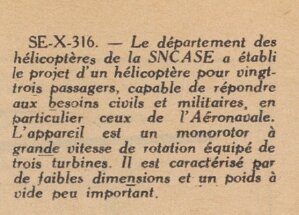
Article 3 March 1955 in Aviation Magazine : https://gallica.bnf.fr/ark:/12148/bpt6k53223495/f15.image.r=SE X 316?rk=21459;2
Not mentioned again in successive issues and years....the search of gallica is pretty good
Last edited:
- Joined
- 26 May 2006
- Messages
- 34,869
- Reaction score
- 15,733
From, Airlifes Helicopters and Rotorcraft.X-380 was a SA-365N with combined composite rotorhub/mast, 5 blade rotor and swept tips
Attachments
persil
All rotorcraft enthusiast
@hesham I am just digging into this one as today is its maiden flight anniversary. But this has not much sense to me. Why presumably newer version has less powerful engine? The oldest book I have which mentions that autogyro id the one by mr Paul Lambermont from 1958 and it does not describe any variants, and the only engine data given is closer to what you wrote, but still different: Bearn 6 DO 5 developing 350 HP.SE-700 was a three-seat passenger autogyro,powered by one 330 hp Béarn 6D-07 engine
SE-700S was an improved version,maybe remained a Project,
SE-701 was a version,intended to carry 700 kg of load,powered by one 220 hp Renault 6Q-01 engine,also known
as SE-700A
SE-702 was a version,featured by a fuselage hull and a fixed front wheel,powered by one 330 hp Béarn 6D-07 engine,
also called SE-700B
I came across some french on-line description which has more sense in regard of engine situation across its versions: https://aviationsmilitaires.net/v3/kb/aircraft/show/1567/sud-est-se-700#tab:tab-historique
And here is bit of it translated by google to english:
It seems that it is a copy-paste text from Wikipedia. As a source, among others, it gives a book: Gaillard, Pierre (1990). Les Avions Francais de 1944 à 1964. Paris: Éditions EPA. p. 33. ISBN 2-85120-350-9. Does someone has its electronic version?The Second World War delayed the program and the aircraft was assembled in Marignane during the Occupation. It could not make its maiden flight until May 25, 1945, in the hands of Stagenburg. It was then powered by a Renault 6Q-01 6-cylinder in line, providing 220 horsepower. The aircraft proved difficult to control and ended up crashing, without too much damage, in January 1946 (the 6th or the 21st depending on the source). Rather than repairing the first prototype, the SNCASE preferred to build a second, more elaborate prototype with a more powerful engine, the SE-700A or even SE-701. Its engine was a Béarn 6D-07 providing 330 horsepower, which was also originally planned for the program.
I need to dive into Flight International archives - maybe there will be some more clues.
Last edited:
- Joined
- 25 June 2014
- Messages
- 1,564
- Reaction score
- 1,499
Great job, stargazer!
SE-1801 Flying wing project derived from the SE-1800
SE-1802 Flying wing project derived from the SE-1800
SE-X201 20 tons, 18 engines! transport flying wing project derived from the SE-X200.
SE-X209 Four seat training and touring jet tailless aircraft project
Just to clarify; these are all tailless aircraft, they are absolutely NOT FLYING WINGS. Avoiding confusion always helps the reader.
Accidentally came across some potentials information about "SE-210 Super Caravelle Atomique" the supposed nuclear power version.
I came across it thanks to @ToughSf Twiter account, and it leads to a Russian site called "aviadejavu." The site is pointing this design to JC Carbonel, which make the pciture looking legit to me.
I came across it thanks to @ToughSf Twiter account, and it leads to a Russian site called "aviadejavu." The site is pointing this design to JC Carbonel, which make the pciture looking legit to me.
The original 1958 dyeline for the conventional turbojet-powered “Super-Caravelle”, on which it was proposed to base a version fitted with turbojets powered by an onboard nuclear reactor.
This original three-view from the nuclear-powered Super-Caravelle brochure shows some of the proposed version’s salient features, including, RIGHT, the strengthened four-wheel bogie main undercarriage and the nuclear pile located aft of the stowed mainwheels, BELOW.
Detail drawings showing, from furthest right, front and side views of the beefed-up mainwheel units with four wheels, and the twin nosewheel arrangement. All of them were designed to offer extra strength on the basis that, on a nuclear-powered variant with little conventional fuel aboard, landing weights would be much the same as those for take-off.
Sud Aviation’s March 1958 brochure for a "Super-Caravelle" included an illustration for a nuclear-powered turbojet unit fitted to the tail powerplant mounting of a standard Caravelle, redrawn here by JUANITA FRANZI. The nuclear reactor or "pile" would replace the need for conventional fuel and provide power for the otherwise-conventional turbojet powerplant arrangement.
LEFT Sud provided illustrations for both direct-flow (open-circuit) and indirect-flow (closed-circuit) propulsion systems for the nuclear Super-Caravelle. This drawing shows the indirect method, which, it was thought, would emit less radiation and therefore require less protective armour, and was thus favoured for development.
RIGHT The drawing for the direct-flow (open-circuit) method, which would eject radioactive air in its exhaust, deemed unacceptable for obvious reasons! The entire concept would throw up problems that would be difficult to solve, and ultimately the nuclear power idea was discreetly dropped. Three views of the cockpit as provided in the brochure for the nuclear airliner; how its layout may have differed was not specified.
Attachments
- Joined
- 26 May 2006
- Messages
- 34,869
- Reaction score
- 15,733
- From post war,SNCASE used a 300 series for helicopter ;-
X-300 to X-309 were unknown designs
X-310A,B,C,D,E & F were a lightweight helicopter Projects,powered by one turboshaft engine
X-310G was a lightweight helicopter,powered by one 530 hp Turbomeca Artouste IIC6 turboshaft engine,later
developed into SE-3130 Alouette
X-311 Helibus was a tandem main rotor medium transport helicopter Project,could accommodated 30 passenger,
powered by two 400 Turbomeca turbine engines
X-312,X-313 & X-314 were unknown designs
X-315 was a seven-seat utility and light flying crane helicopter Project,with single rotor and powered by two
turbine engines
X-316 was a twenty three seat commercial and military transport helicopter Project of 1955,led to develop
SE-3200 Frelon
X-3XX was a large flaying crane helicopter Project,with a payload 16.000-24.000 1b,and designed in co-operated
with Agusta and a company from Germany,1959
From Air Pictorial 1959
Attachments
- Joined
- 26 May 2006
- Messages
- 34,869
- Reaction score
- 15,733
X-300 was a five-seat light helicopter Project,led to develop SA-340 Gazelle
From Air Pictorial 1966.
Attachments
- Joined
- 25 June 2009
- Messages
- 14,749
- Reaction score
- 6,112
Hesham's lists are precious but I find it annoying that the designations are not written the way they should.
The use of a hyphen (-) was not common practice in French designations. The X series used a point, but the SE series didn't use any hyphen, dash or point. Here are a few designations I can add from my own lists:
SE 101 was a ground attack, not fighter, version of the LeO 50 (1952)
SE 104 long-range transatlantic flying boat project (9 tons of cargo + 70 passengers)
SE 112 no data
SE 200 ROCHAMBEAU (not AMPHITRITE, which was the LeO name for it)
SE 247 military derivative version of LeO H-47 (1945)
SE 1610 ground-to-ground missile (SS 20)
SE 1710 ground-to-ground missile (SS 20)
SE 1900/1910 were wheel carts, not "cars"
SE 3131 ALOUETTE GOUVERNEUR VIP version
SE 4241 variant of SE 4200
SE 4261 variant of SE 4200
SE 4350 variant of SE 4300 (150 ordered and 89 actually built)
SE 6000 projected supersonic interceptor
Also, the SE 700/701 autogyro design was called the ALOUETTE, before the name was applied to the later helicopters, and the SE 3140 was the ALOUETTE GOUVERNEUR, likely similar to the SE 3131.
There is apparently a conflict of designations over the SE 1500, which is also listed as a tourism glider.
The use of a hyphen (-) was not common practice in French designations. The X series used a point, but the SE series didn't use any hyphen, dash or point. Here are a few designations I can add from my own lists:
SE 101 was a ground attack, not fighter, version of the LeO 50 (1952)
SE 104 long-range transatlantic flying boat project (9 tons of cargo + 70 passengers)
SE 112 no data
SE 200 ROCHAMBEAU (not AMPHITRITE, which was the LeO name for it)
SE 247 military derivative version of LeO H-47 (1945)
SE 1610 ground-to-ground missile (SS 20)
SE 1710 ground-to-ground missile (SS 20)
SE 1900/1910 were wheel carts, not "cars"
SE 3131 ALOUETTE GOUVERNEUR VIP version
SE 4241 variant of SE 4200
SE 4261 variant of SE 4200
SE 4350 variant of SE 4300 (150 ordered and 89 actually built)
SE 6000 projected supersonic interceptor
Also, the SE 700/701 autogyro design was called the ALOUETTE, before the name was applied to the later helicopters, and the SE 3140 was the ALOUETTE GOUVERNEUR, likely similar to the SE 3131.
There is apparently a conflict of designations over the SE 1500, which is also listed as a tourism glider.
- Joined
- 26 May 2006
- Messages
- 34,869
- Reaction score
- 15,733
Hesham's lists are precious but I find it annoying that the designations are not written the way they should.
The use of a hyphen (-) was not common practice in French designations. The X series used a point, but the SE series didn't use any hyphen, dash or point. Here are a few designations I can add from my own lists:
SE 101 was a ground attack, not fighter, version of the LeO 50 (1952)
SE 104 long-range transatlantic flying boat project (9 tons of cargo + 70 passengers)
SE 112 no data
SE 200 ROCHAMBEAU (not AMPHITRITE, which was the LeO name for it)
SE 247 military derivative version of LeO H-47 (1945)
SE 1610 ground-to-ground missile (SS 20)
SE 1710 ground-to-ground missile (SS 20)
SE 1900/1910 were wheel carts, not "cars"
SE 3131 ALOUETTE GOUVERNEUR VIP version
SE 4241 variant of SE 4200
SE 4261 variant of SE 4200
SE 4350 variant of SE 4300 (150 ordered and 89 actually built)
SE 6000 projected supersonic interceptor
Also, the SE 700/701 autogyro design was called the ALOUETTE, before the name was applied to the later helicopters, and the SE 3140 was the ALOUETTE GOUVERNEUR, likely similar to the SE 3131.
There is apparently a conflict of designations over the SE 1500, which is also listed as a tourism glider.
Many thanks,and I agree about these designations,
SE 112,200,247,1610,1710,1900,1910,3131,4241,4261 & 4350.
For SE 101,was a three-seat heavy fighter project in C.3 category as in my new book and also according to the book,SNACSE SE 100 Chasseur Lord Polyvalent,
and the only ground attack versions are SE 102 &103.
About SE 104,it was the same as X-104,and they called it SE X-104,but in briefly,
or shortly they referred to it as SE-104,in many source they did that.
To SE 6000,there is no confirm about it.
Also OK for SE 700 & 701,but what is the source about SE 1500 tourism glider ?.
- Joined
- 25 June 2009
- Messages
- 14,749
- Reaction score
- 6,112
Both the SE 1500 and SE 6000 were found on the website http://vignaud.org/To SE 6000,there is no confirm about it.
Also OK for SE 700 & 701,but what is the source about SE 1500 tourism glider ?.
- Joined
- 26 May 2006
- Messages
- 34,869
- Reaction score
- 15,733
Both the SE 1500 and SE 6000 were found on the website http://vignaud.org/
By the way,the founder is a member in this forum,and source for SE 6000
is me,I saw it on Internet,but no evidence for its existing,about SE.1500,
we can ask him about it.
SNCASE SE.1500 Series
Hello everyone, for my first suggestion I would like to tell you about the SNCASE SE 1500 and its derivatives for LeO 451. Part I, History Spoiler 1945 ,On the ruins of the defeated Third Reich, the allies sent teams to study and recover as much German war technology as possible. The French were ...
Attachments
Last edited:
- Joined
- 15 February 2024
- Messages
- 500
- Reaction score
- 1,302
Maybe some clarifications are needed: in January 1943, Vichy government decided to change all designations of planes produced for the French State, as you can see here:SE 200 ROCHAMBEAU (not AMPHITRITE, which was the LeO name for it)
Also, the SE 700/701 autogyro design was called the ALOUETTE, before the name was applied to the later helicopters, and the SE 3140 was the ALOUETTE GOUVERNEUR, likely similar to the SE 3131.
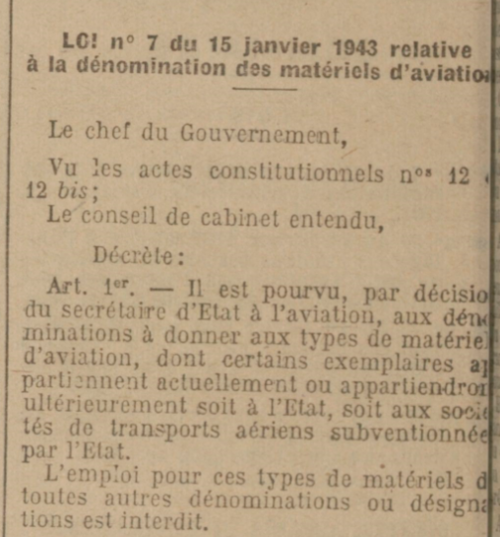
Article 1 indicates that the use of any other names or designations for these types of materials is prohibited.
Then, the official list of new names was published end of March. The first letter "A" was assigned to SNCASE ("B" for SNCASO, "C" for Breguet, etc.). This the origin of the baptismal names "Amphitrite" for SE-200 (years after LeO H49) and "Alouette" as well, as you can see here:

The SE.3140 is another topic, but it is not the Gouverneur. SE.3140, nicknamed "Alouette-Turmo" was just an SE.3130 re-engined with a Turboméca Turmo II.
Last edited:
- Joined
- 15 February 2024
- Messages
- 500
- Reaction score
- 1,302
It is not just a project.: the SE.4100 (former NC.3500) first launch took place the 29th September 1949.SE-4100 was a first French missile, Project only
Attachments
Last edited:
- Joined
- 25 June 2009
- Messages
- 14,749
- Reaction score
- 6,112
Absolutely fascinating stuff! Is it possible to have the entire list of names?Article 1 indicates that the use of any other names or designations for these types of materials is prohibited.
Then, the official list of new names was published end of March. The first letter "A" was assigned to SNCASE ("B" for SNCASO, "C" for Breguet, etc.). This the origin of the baptismal names "Amphitrite" for SE-200 (years after LeO H49) and "Alouette" as well, as you can see here:
Last edited:
- Joined
- 15 February 2024
- Messages
- 500
- Reaction score
- 1,302
Not really, as you can see here: https://www.secretprojects.co.uk/th...r-flying-boat-projects.841/page-2#post-678640SE-900 maybe a three engined large Project version of SE-100,intended as bomber or transport aircraft,need confirm
- Joined
- 15 February 2024
- Messages
- 500
- Reaction score
- 1,302
X-410 is a Mach 2 air-ground missile (1961)X-409 & X-410 were unknown designs
- Joined
- 15 February 2024
- Messages
- 500
- Reaction score
- 1,302
Only X-421 was a ramjet-powered missile:X-411 to X-421 were a Projects of a ramjet-powered cruise missiles
X-411: Mach 2 air to ground missile, max altitude 200 m. Adaptation of the X-410 for low altitude flight. (1961)
X-412: Mach 2 ground to ground tactical missile, max altitude 200 m, with 2 rocket boosters. (1961)
X-413: Mach 2 ground to ground missile for tactical reconnaissance, max altitude 200 m, with 2 rocket boosters. (1961)
X-414: Mach 2 air to ground missile, max altitude 200 m, launched by TCS (Super-Caravelle). (1961)
X-415: Rocket air to ground missile, launched by Mirage IV. (1961)
X-416: 2-stage rocket, launched by TCS. (1962)
X-417: supersonic air to ground missile "Robot","AS2". For "Minerve" project. (1962)
X-418: ground to ground tactical missile. For "Minerve" project. (1962)
X-419: ground to ground or sea to ground missile. For "Minerve" project. (1963)
X-420: short range ground to ground missile. For "Minerve" project. (1963)
X-421: ramjet-powered cruise missile. (1964)
X-422: see attached.
Attachments
- Joined
- 15 February 2024
- Messages
- 500
- Reaction score
- 1,302
I don't agree: there is no evidences that these designation were ever assigned to any project. You always suppose that if there is a hole in designation sequence, it means that the corresponding numbers were assigned to unknown project. I can confirm that in some cases, this is simply wrong. Sometimes, numbers were just reserved "in case of..." or simply jumped, but never used at the end. Some manufacturers also assign different meanings to the last digit, such as 0 for prototype, 1 for preseries or variants, 2 for series, 3 for foreign export, etc. It fully depends on the manufacturer and the time period.SE-533 & SE-534 Mistral were unknown variants,maybe a Projects
So, as far as you don't have any trace of such projects, I suggest you to don't take initiative to fill the holes. By doing such, you introduce false information that will be repeated and create "legends".
No evidences, I suggest you to remove those entries.SE-201 & SE-202 were unknown variants,maybe a Projects only
No evidence. I suggests you to remove those entries.SE-205 & SE-206 were unknown Project versions
Idem, except for SE-210 which is well known: it was called "Caravelle".SE-208,SE-209,SE-210 & SE-211 were unknown Project versions
Never heard about such project. Nevertheless, the SE-212 is also well known: it's the "Durandal". 2 prototypes built and flown. They derived from X-212 generic study.SE-212 was a Project version of SE-200,powered by six Gnôme-Rhône 18R, wing area increase of 35 m° and 90 ton empty weight
Never heard of it. Probably a typo for SE-700 version?SE-300 was a light transport autogyro Project,powered by one 350 hp Gnôme-Rhône engine
- SE-300 was the former Romano 111 T3 project.
- SE-300T was a flying boat project, tested in wind-tunnel at Toulouse during the War.
- SE-301: project, tested in wind-tunnel in March and April 1941.
Additional designations for your list:
- SE-116 "Voltigeur". 2 prototypes built (ex X-116A and X-116B)
- SE-117 "Voltigeur": 1 prototype built, ex SE-116-03
- SE-118 "Diplomate": project for 8-10 passenger transport version
- SE-119: project derived from SE-117.
- SE-216 "Fonceur": project derived from above family.
No: the SE-1700 was a ground-to-ground missile, using flying-wing design. It was supposed to be launched from the SE-1900.SE-1700 unknown Project,maybe a tourism glider,need confirm
A variant using pulse-jet engine was called SE-1710.
In the same series you have the SE-1600 with additional vertical control surfaces, but you can also add its version SE-1610 using pulse-jet. All were planned for using SE-1900 launcher.
- Joined
- 25 June 2009
- Messages
- 14,749
- Reaction score
- 6,112
I have desperately tried to tell hesham the same thing for over 10 years now... Once something is written, it somehow acquires existence, and can lead others to confusion. I have seen that happens dozens of times.So, as far as you don't have any trace of such projects, I suggest you to don't take initiative to fill the holes. By doing such, you introduce false information that will be repeated and create "legends".
- Joined
- 15 February 2024
- Messages
- 500
- Reaction score
- 1,302
Wrong: the SE-3100 fying model is the SE-3101.SE-3001 was a flying model of the SE-3100
SE-3010 was unknown Project,need confirm
SE-3010: no evidence. Probably another typo. I suggest to remove it.
- Joined
- 15 February 2024
- Messages
- 500
- Reaction score
- 1,302
X-300 was the initial study for HLU and HLO (Light Helicopter for Utility or Observation). It became the SE-340 "Gazelle".- From post war,SNCASE used a 300 series for helicopter ;-
X-300 to X-309 were unknown designs
For the other ones, I suggest to move them here: https://www.secretprojects.co.uk/forums/alternative-history-and-future-speculation.42/ or here: https://www.secretprojects.co.uk/forums/theoretical-fake-and-generic-projects.44/
- Joined
- 15 February 2024
- Messages
- 500
- Reaction score
- 1,302
I never found any trace of such project. The SNCASE assigned each slice of 1000 to different design offices:SE 6000 projected supersonic interceptor
1000: Marignane (Poitou / Gross)
2000: Toulouse (Satre)
3000: La Courneuve (Renoux, then Mouille / Marchetti)
4000: Cannes (Marnay)
5000: La Courneuve (Jakimiuk)
As far as I know, there was no design office assigned to 6000 series.
- Joined
- 26 May 2006
- Messages
- 34,869
- Reaction score
- 15,733
Many thanks to you my dear Philippe,
but you mixed between two designations ?!,the early SE-200 series are for a developed versions or
projects from SE-200 Amphitrite, and as mentioned in some sources,from SE-200 up to SE-212,it
clearly mentioned after that,the series X-200s and when and concept became a prototype or entered
production,the company re-allocated or re-named it as SE-200s,such as X-210 became SE-210 and
X-212 became SE-212.
What ?,in TU magazine and Retrohydro site,it's as I explained,please see the picture (11)
That's also from a reliable source,but I don't remember it now,and may this was
the early designation,then changed into SE-3101.
but you mixed between two designations ?!,the early SE-200 series are for a developed versions or
projects from SE-200 Amphitrite, and as mentioned in some sources,from SE-200 up to SE-212,it
clearly mentioned after that,the series X-200s and when and concept became a prototype or entered
production,the company re-allocated or re-named it as SE-200s,such as X-210 became SE-210 and
X-212 became SE-212.
Never heard of it. Probably a typo for SE-700 version?
- SE-300 was the former Romano 111 T3 project.
- SE-300T was a flying boat project, tested in wind-tunnel at Toulouse during the War.
- SE-301: project, tested in wind-tunnel in March and April 1941.
What ?,in TU magazine and Retrohydro site,it's as I explained,please see the picture (11)
Wrong: the SE-3100 fying model is the SE-3101
That's also from a reliable source,but I don't remember it now,and may this was
the early designation,then changed into SE-3101.
Attachments
- Joined
- 26 May 2006
- Messages
- 34,869
- Reaction score
- 15,733
X-300 was the initial study for HLU and HLO (Light Helicopter for Utility or Observation). It became the SE-340 "Gazelle".
Again ?,you mixed between early X-300 series from after the WWII which raised up to X-316,maybe more,
and the another series of X-200,which reached X-225,then raised as from X-230,240,250 ........,passing 300, up
to X-380.
Please have a good looking to replies # 86 and 100.
- Joined
- 15 February 2024
- Messages
- 500
- Reaction score
- 1,302
Hello,Again ?,you mixed between early X-300 series from after the WWII which raised up to X-316,maybe more,
and the another series of X-200,which reached X-225,then raised as from X-230,240,250 ........,passing 300, up
to X-380.
Please have a good looking to replies # 86 and 100.
I think you are mixing the designations, not me. The false idea to have an X-300 in sequence after X-230, 240, 250 etc. is a pure mistake from your side. You misundertand how the numbering was assigned by SNCASE.
Initially, the SNCASE X- series are assigned to design offices, as it was the case during the war for the slides of 1000 to 4000 for manufacturing: X-100 Marignane, X-200 Toulouse, X-300 La Courneuve helicopters, X-400 Cannes and X-500 for La Courneuve aircraft department (Jakimiuk joined the company after the war, and series 5000 was added, and then assigned to his team). Renoux did not use the X-3xx designation, neither Marchetti. This is only René Mouille who decided to use the X-xxx series for technological studies. Then he started with the HLU/HLO with 1/7 models, mainly to introduce the first composite material usage in helicopter structure.
Generally speaking, the X series was used by SNCASE after WW2 for generic studies or technological demontrators, not for projects and prototypes. When prototypes are purchased by public order, the designation is changed.
For example, the X-116 A and B "Fonceur" were ordered as SE-116-01 and 02 "Voltigeur". The SE-116-03 became SE-117. Their succesors were designated SE-118 and 119.There were never any X-117, 118, 119.
Other examples: X-210A to X-210G were studied by Pierre Satre, but when X-210G was selected, it became SE-210 "Caravelle". It's the same for X-212 generic proposals. When the Delta with mixed jet and rocket engine formula was selected, it became SE-212 "Durandal". Then, X-212 was discontinued and what you called X-212 "Durandal" is wrong, this name was assigned to SE-212, not X-212.
After the fusion between SNCASE and SNCASO, the company became Sud Aviation (SA-xxx), then SNIAS when they absorbed Nord-Aviation (AS-xxx). They continued using X-xxx series, but they opened the numbering to other sequences.
Last edited:
- Joined
- 15 February 2024
- Messages
- 500
- Reaction score
- 1,302
This is 100% false!That's also from a reliable source,but I don't remember it now,and may this was
the early designation,then changed into SE-3101.
I have published the detailed history of SE-3101 helicopter in Le Fana de l'Aviation n° 323 in October 1996.
Similar threads
-
SNCASE (Sud-Est) SE.1200 helicopter project
- Started by hesham
- Replies: 3
-
-
-
-

